Cooperative Spectrum Sensing in Cognitive Radio Networks
VerifiedAdded on 2023/06/14
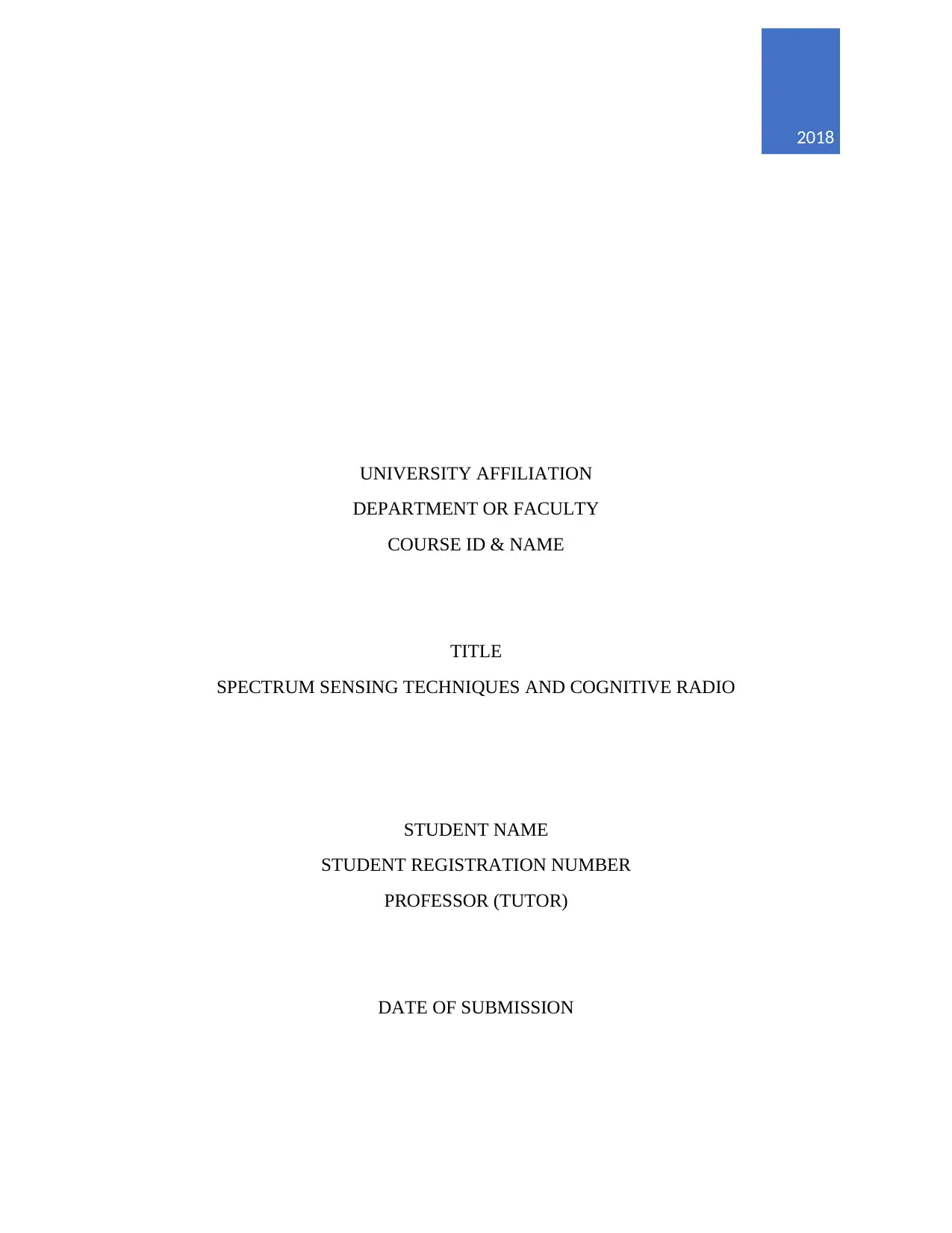
DEPARTMENT OR FACULTY
COURSE ID & NAME
TITLE
SPECTRUM SENSING TECHNIQUES AND COGNITIVE RADIO
STUDENT NAME
STUDENT REGISTRATION NUMBER
PROFESSOR (TUTOR)
DATE OF SUBMISSION
2018
Paraphrase This Document
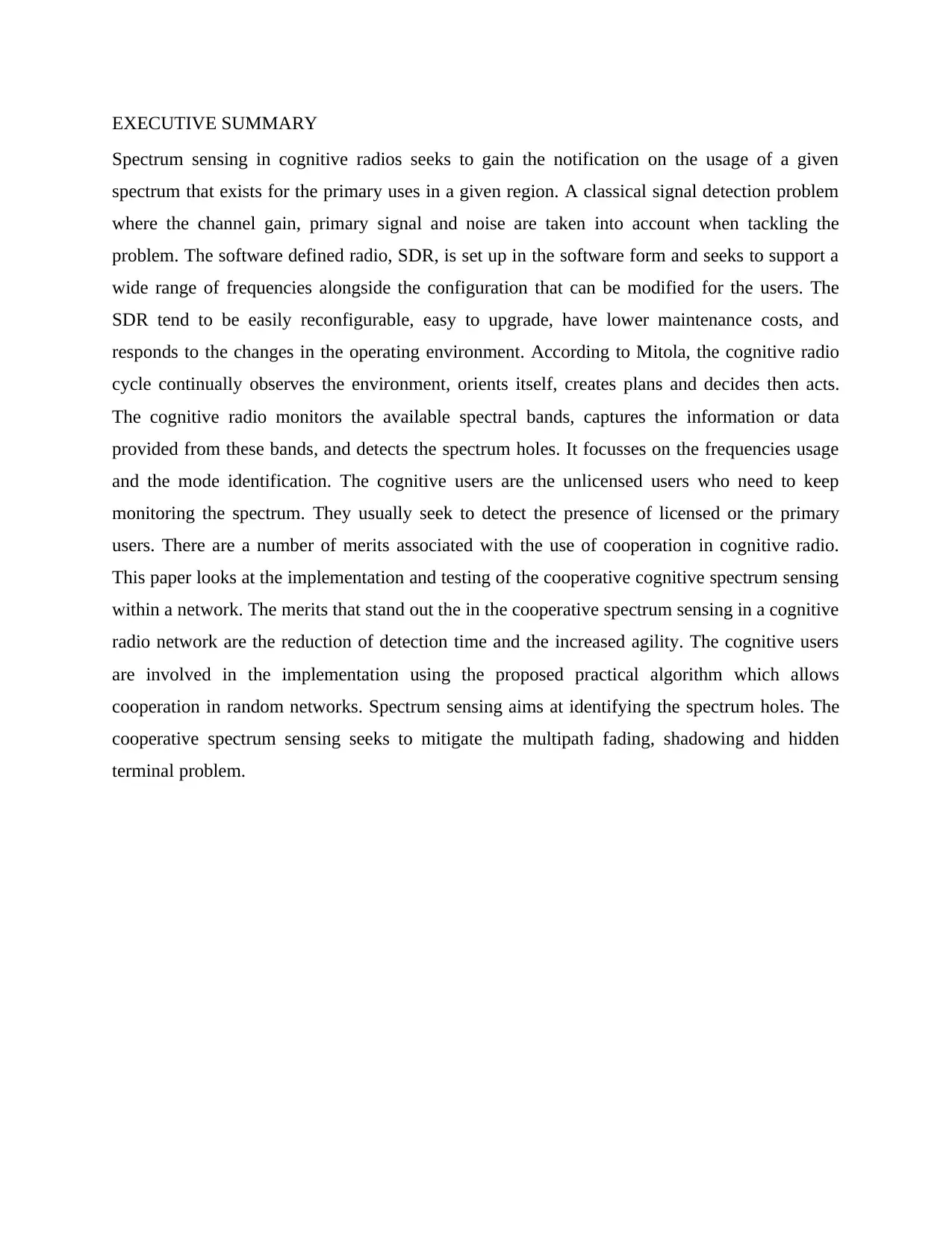
Spectrum sensing in cognitive radios seeks to gain the notification on the usage of a given
spectrum that exists for the primary uses in a given region. A classical signal detection problem
where the channel gain, primary signal and noise are taken into account when tackling the
problem. The software defined radio, SDR, is set up in the software form and seeks to support a
wide range of frequencies alongside the configuration that can be modified for the users. The
SDR tend to be easily reconfigurable, easy to upgrade, have lower maintenance costs, and
responds to the changes in the operating environment. According to Mitola, the cognitive radio
cycle continually observes the environment, orients itself, creates plans and decides then acts.
The cognitive radio monitors the available spectral bands, captures the information or data
provided from these bands, and detects the spectrum holes. It focusses on the frequencies usage
and the mode identification. The cognitive users are the unlicensed users who need to keep
monitoring the spectrum. They usually seek to detect the presence of licensed or the primary
users. There are a number of merits associated with the use of cooperation in cognitive radio.
This paper looks at the implementation and testing of the cooperative cognitive spectrum sensing
within a network. The merits that stand out the in the cooperative spectrum sensing in a cognitive
radio network are the reduction of detection time and the increased agility. The cognitive users
are involved in the implementation using the proposed practical algorithm which allows
cooperation in random networks. Spectrum sensing aims at identifying the spectrum holes. The
cooperative spectrum sensing seeks to mitigate the multipath fading, shadowing and hidden
terminal problem.

INTRODUCTION.......................................................................................................................................3
LITERATURE REVIEW............................................................................................................................4
SPECTRUM SENSING..........................................................................................................................4
DYNAMIC SPECTRUM ACCESS........................................................................................................7
TYPES OF SPECTRUM SENSING.........................................................................................................10
COOPERATIVE SPECTRUM SENSING............................................................................................10
RELATIVE PERFORMANCE MEASURES...........................................................................................13
SPECTRUM SENSING BANDWIDTH...............................................................................................13
TRANSMISSION TYPE SENSING.....................................................................................................14
SPECTRUM SENSING ACCURACY.................................................................................................14
SPECTRUM SENSING COMPLEXITIES AND LIMITATIONS...........................................................19
CONCLUSION.........................................................................................................................................23
REFERENCES..........................................................................................................................................23
APPENDIX...............................................................................................................................................23
⊘ This is a preview!⊘
Do you want full access?
Subscribe today to unlock all pages.

Trusted by 1+ million students worldwide
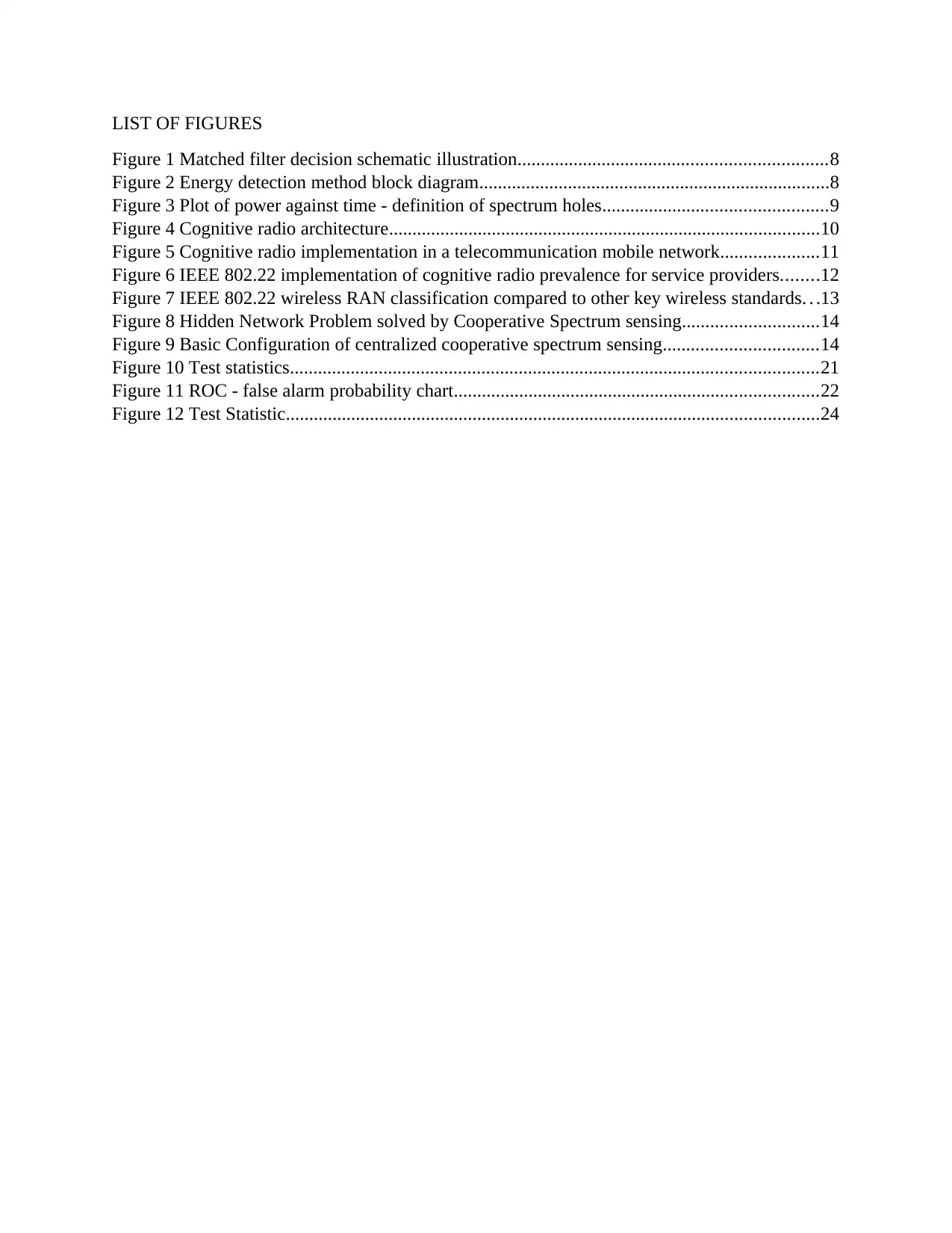
Figure 1 Matched filter decision schematic illustration..................................................................8
Figure 2 Energy detection method block diagram...........................................................................8
Figure 3 Plot of power against time - definition of spectrum holes................................................9
Figure 4 Cognitive radio architecture............................................................................................10
Figure 5 Cognitive radio implementation in a telecommunication mobile network.....................11
Figure 6 IEEE 802.22 implementation of cognitive radio prevalence for service providers........12
Figure 7 IEEE 802.22 wireless RAN classification compared to other key wireless standards. . .13
Figure 8 Hidden Network Problem solved by Cooperative Spectrum sensing.............................14
Figure 9 Basic Configuration of centralized cooperative spectrum sensing.................................14
Figure 10 Test statistics.................................................................................................................21
Figure 11 ROC - false alarm probability chart..............................................................................22
Figure 12 Test Statistic..................................................................................................................24
Paraphrase This Document
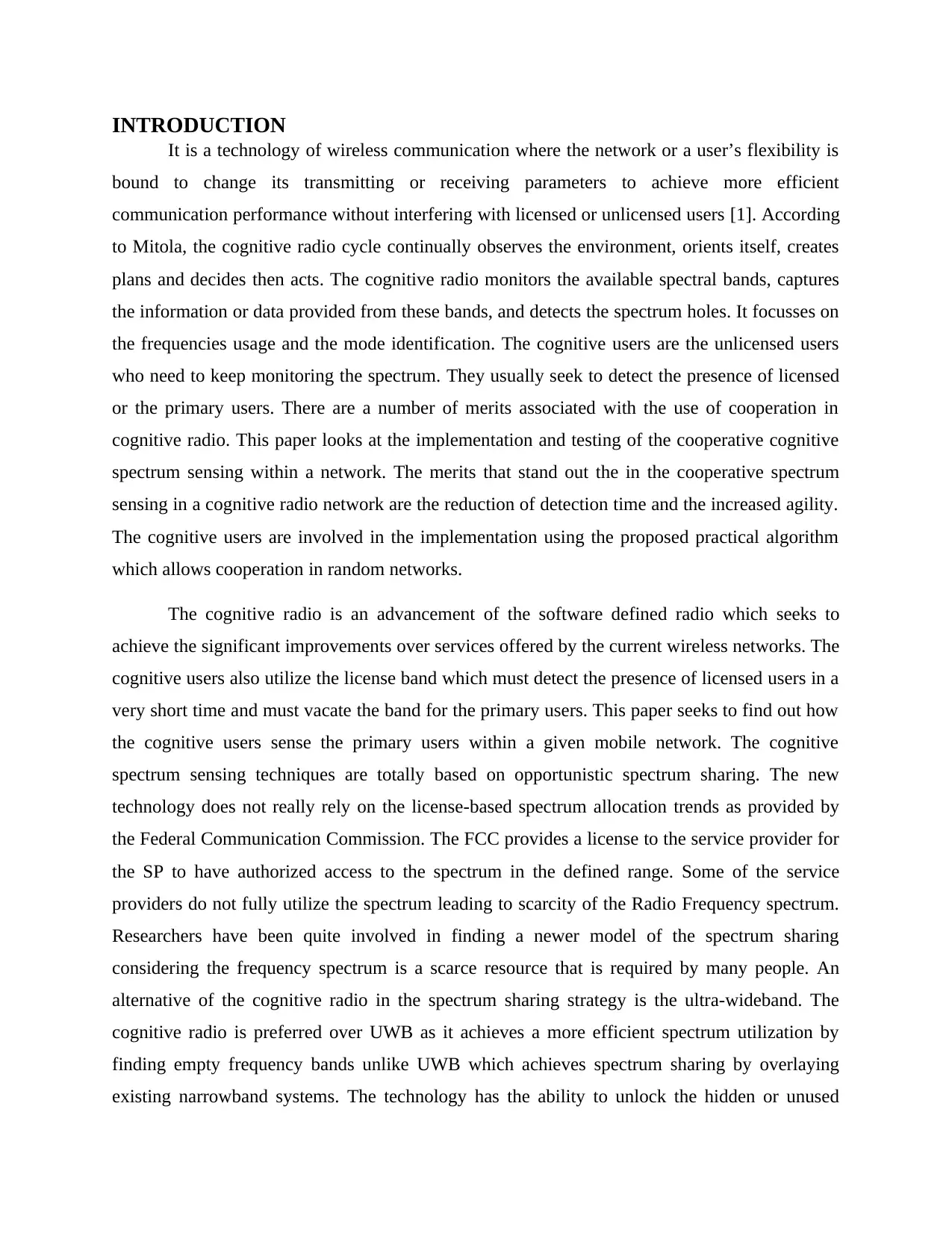
It is a technology of wireless communication where the network or a user’s flexibility is
bound to change its transmitting or receiving parameters to achieve more efficient
communication performance without interfering with licensed or unlicensed users [1]. According
to Mitola, the cognitive radio cycle continually observes the environment, orients itself, creates
plans and decides then acts. The cognitive radio monitors the available spectral bands, captures
the information or data provided from these bands, and detects the spectrum holes. It focusses on
the frequencies usage and the mode identification. The cognitive users are the unlicensed users
who need to keep monitoring the spectrum. They usually seek to detect the presence of licensed
or the primary users. There are a number of merits associated with the use of cooperation in
cognitive radio. This paper looks at the implementation and testing of the cooperative cognitive
spectrum sensing within a network. The merits that stand out the in the cooperative spectrum
sensing in a cognitive radio network are the reduction of detection time and the increased agility.
The cognitive users are involved in the implementation using the proposed practical algorithm
which allows cooperation in random networks.
The cognitive radio is an advancement of the software defined radio which seeks to
achieve the significant improvements over services offered by the current wireless networks. The
cognitive users also utilize the license band which must detect the presence of licensed users in a
very short time and must vacate the band for the primary users. This paper seeks to find out how
the cognitive users sense the primary users within a given mobile network. The cognitive
spectrum sensing techniques are totally based on opportunistic spectrum sharing. The new
technology does not really rely on the license-based spectrum allocation trends as provided by
the Federal Communication Commission. The FCC provides a license to the service provider for
the SP to have authorized access to the spectrum in the defined range. Some of the service
providers do not fully utilize the spectrum leading to scarcity of the Radio Frequency spectrum.
Researchers have been quite involved in finding a newer model of the spectrum sharing
considering the frequency spectrum is a scarce resource that is required by many people. An
alternative of the cognitive radio in the spectrum sharing strategy is the ultra-wideband. The
cognitive radio is preferred over UWB as it achieves a more efficient spectrum utilization by
finding empty frequency bands unlike UWB which achieves spectrum sharing by overlaying
existing narrowband systems. The technology has the ability to unlock the hidden or unused
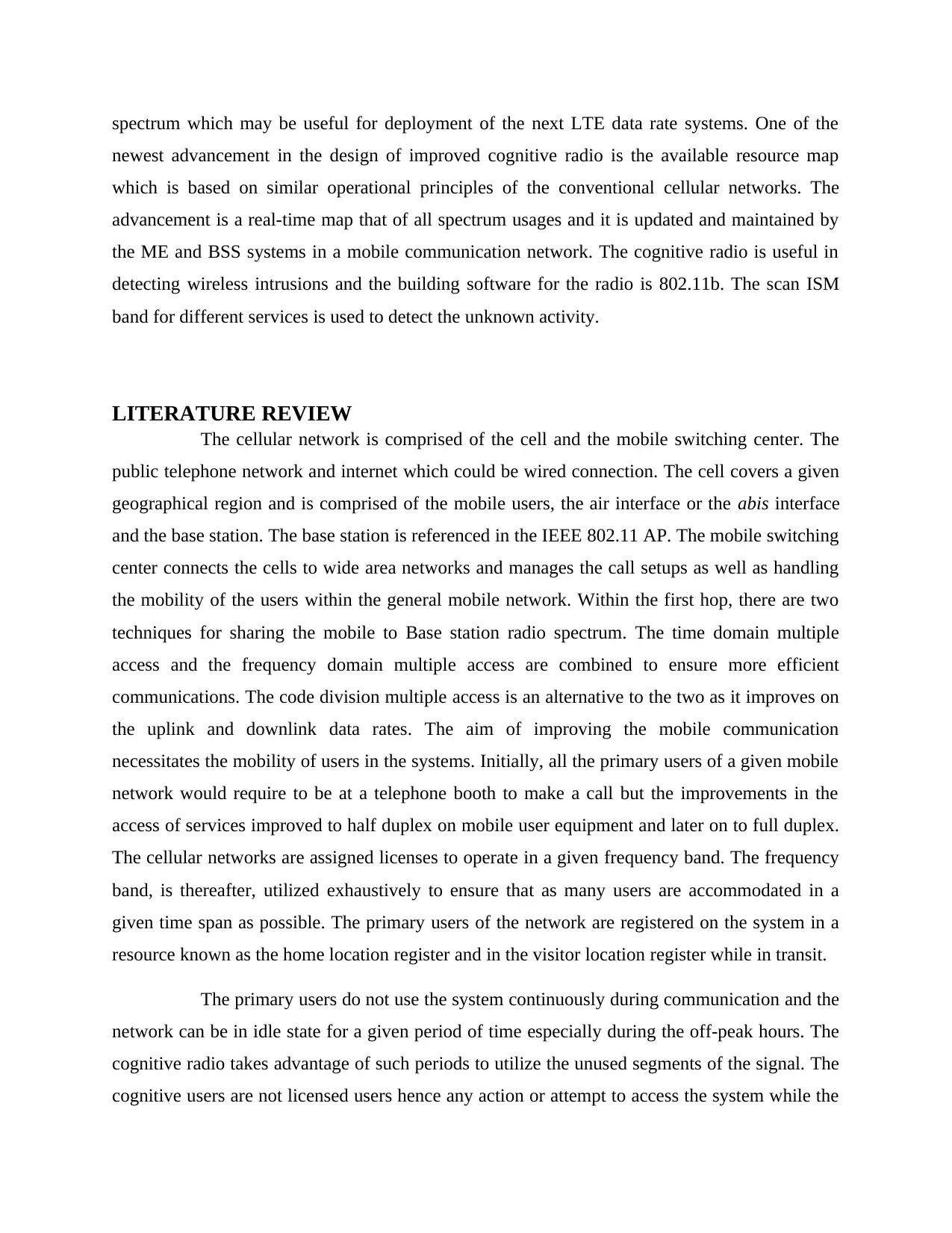
newest advancement in the design of improved cognitive radio is the available resource map
which is based on similar operational principles of the conventional cellular networks. The
advancement is a real-time map that of all spectrum usages and it is updated and maintained by
the ME and BSS systems in a mobile communication network. The cognitive radio is useful in
detecting wireless intrusions and the building software for the radio is 802.11b. The scan ISM
band for different services is used to detect the unknown activity.
LITERATURE REVIEW
The cellular network is comprised of the cell and the mobile switching center. The
public telephone network and internet which could be wired connection. The cell covers a given
geographical region and is comprised of the mobile users, the air interface or the abis interface
and the base station. The base station is referenced in the IEEE 802.11 AP. The mobile switching
center connects the cells to wide area networks and manages the call setups as well as handling
the mobility of the users within the general mobile network. Within the first hop, there are two
techniques for sharing the mobile to Base station radio spectrum. The time domain multiple
access and the frequency domain multiple access are combined to ensure more efficient
communications. The code division multiple access is an alternative to the two as it improves on
the uplink and downlink data rates. The aim of improving the mobile communication
necessitates the mobility of users in the systems. Initially, all the primary users of a given mobile
network would require to be at a telephone booth to make a call but the improvements in the
access of services improved to half duplex on mobile user equipment and later on to full duplex.
The cellular networks are assigned licenses to operate in a given frequency band. The frequency
band, is thereafter, utilized exhaustively to ensure that as many users are accommodated in a
given time span as possible. The primary users of the network are registered on the system in a
resource known as the home location register and in the visitor location register while in transit.
The primary users do not use the system continuously during communication and the
network can be in idle state for a given period of time especially during the off-peak hours. The
cognitive radio takes advantage of such periods to utilize the unused segments of the signal. The
cognitive users are not licensed users hence any action or attempt to access the system while the
⊘ This is a preview!⊘
Do you want full access?
Subscribe today to unlock all pages.

Trusted by 1+ million students worldwide
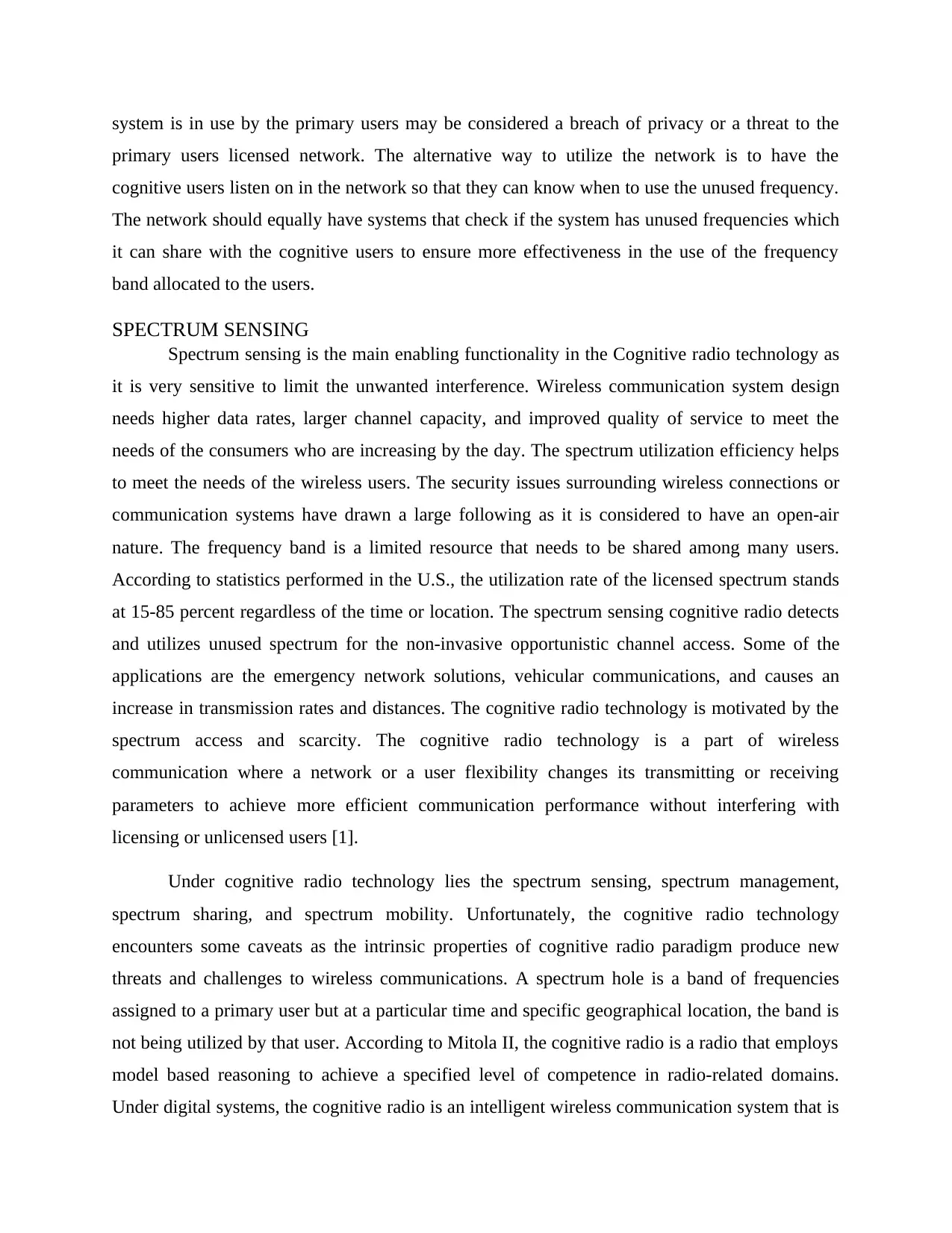
primary users licensed network. The alternative way to utilize the network is to have the
cognitive users listen on in the network so that they can know when to use the unused frequency.
The network should equally have systems that check if the system has unused frequencies which
it can share with the cognitive users to ensure more effectiveness in the use of the frequency
band allocated to the users.
SPECTRUM SENSING
Spectrum sensing is the main enabling functionality in the Cognitive radio technology as
it is very sensitive to limit the unwanted interference. Wireless communication system design
needs higher data rates, larger channel capacity, and improved quality of service to meet the
needs of the consumers who are increasing by the day. The spectrum utilization efficiency helps
to meet the needs of the wireless users. The security issues surrounding wireless connections or
communication systems have drawn a large following as it is considered to have an open-air
nature. The frequency band is a limited resource that needs to be shared among many users.
According to statistics performed in the U.S., the utilization rate of the licensed spectrum stands
at 15-85 percent regardless of the time or location. The spectrum sensing cognitive radio detects
and utilizes unused spectrum for the non-invasive opportunistic channel access. Some of the
applications are the emergency network solutions, vehicular communications, and causes an
increase in transmission rates and distances. The cognitive radio technology is motivated by the
spectrum access and scarcity. The cognitive radio technology is a part of wireless
communication where a network or a user flexibility changes its transmitting or receiving
parameters to achieve more efficient communication performance without interfering with
licensing or unlicensed users [1].
Under cognitive radio technology lies the spectrum sensing, spectrum management,
spectrum sharing, and spectrum mobility. Unfortunately, the cognitive radio technology
encounters some caveats as the intrinsic properties of cognitive radio paradigm produce new
threats and challenges to wireless communications. A spectrum hole is a band of frequencies
assigned to a primary user but at a particular time and specific geographical location, the band is
not being utilized by that user. According to Mitola II, the cognitive radio is a radio that employs
model based reasoning to achieve a specified level of competence in radio-related domains.
Under digital systems, the cognitive radio is an intelligent wireless communication system that is
Paraphrase This Document
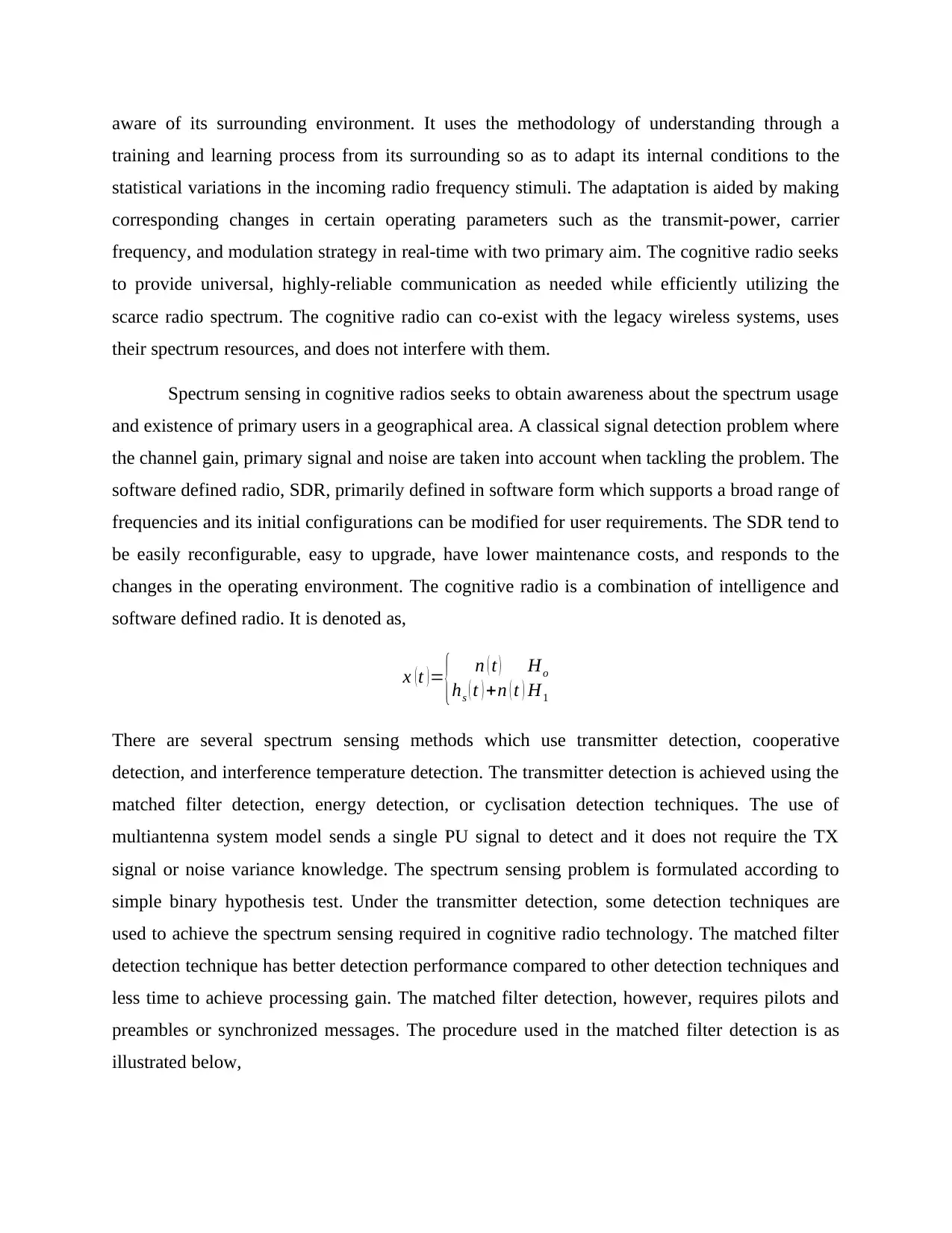
training and learning process from its surrounding so as to adapt its internal conditions to the
statistical variations in the incoming radio frequency stimuli. The adaptation is aided by making
corresponding changes in certain operating parameters such as the transmit-power, carrier
frequency, and modulation strategy in real-time with two primary aim. The cognitive radio seeks
to provide universal, highly-reliable communication as needed while efficiently utilizing the
scarce radio spectrum. The cognitive radio can co-exist with the legacy wireless systems, uses
their spectrum resources, and does not interfere with them.
Spectrum sensing in cognitive radios seeks to obtain awareness about the spectrum usage
and existence of primary users in a geographical area. A classical signal detection problem where
the channel gain, primary signal and noise are taken into account when tackling the problem. The
software defined radio, SDR, primarily defined in software form which supports a broad range of
frequencies and its initial configurations can be modified for user requirements. The SDR tend to
be easily reconfigurable, easy to upgrade, have lower maintenance costs, and responds to the
changes in the operating environment. The cognitive radio is a combination of intelligence and
software defined radio. It is denoted as,
x ( t ) = { n ( t )
hs ( t ) +n ( t )
Ho
H1
There are several spectrum sensing methods which use transmitter detection, cooperative
detection, and interference temperature detection. The transmitter detection is achieved using the
matched filter detection, energy detection, or cyclisation detection techniques. The use of
multiantenna system model sends a single PU signal to detect and it does not require the TX
signal or noise variance knowledge. The spectrum sensing problem is formulated according to
simple binary hypothesis test. Under the transmitter detection, some detection techniques are
used to achieve the spectrum sensing required in cognitive radio technology. The matched filter
detection technique has better detection performance compared to other detection techniques and
less time to achieve processing gain. The matched filter detection, however, requires pilots and
preambles or synchronized messages. The procedure used in the matched filter detection is as
illustrated below,
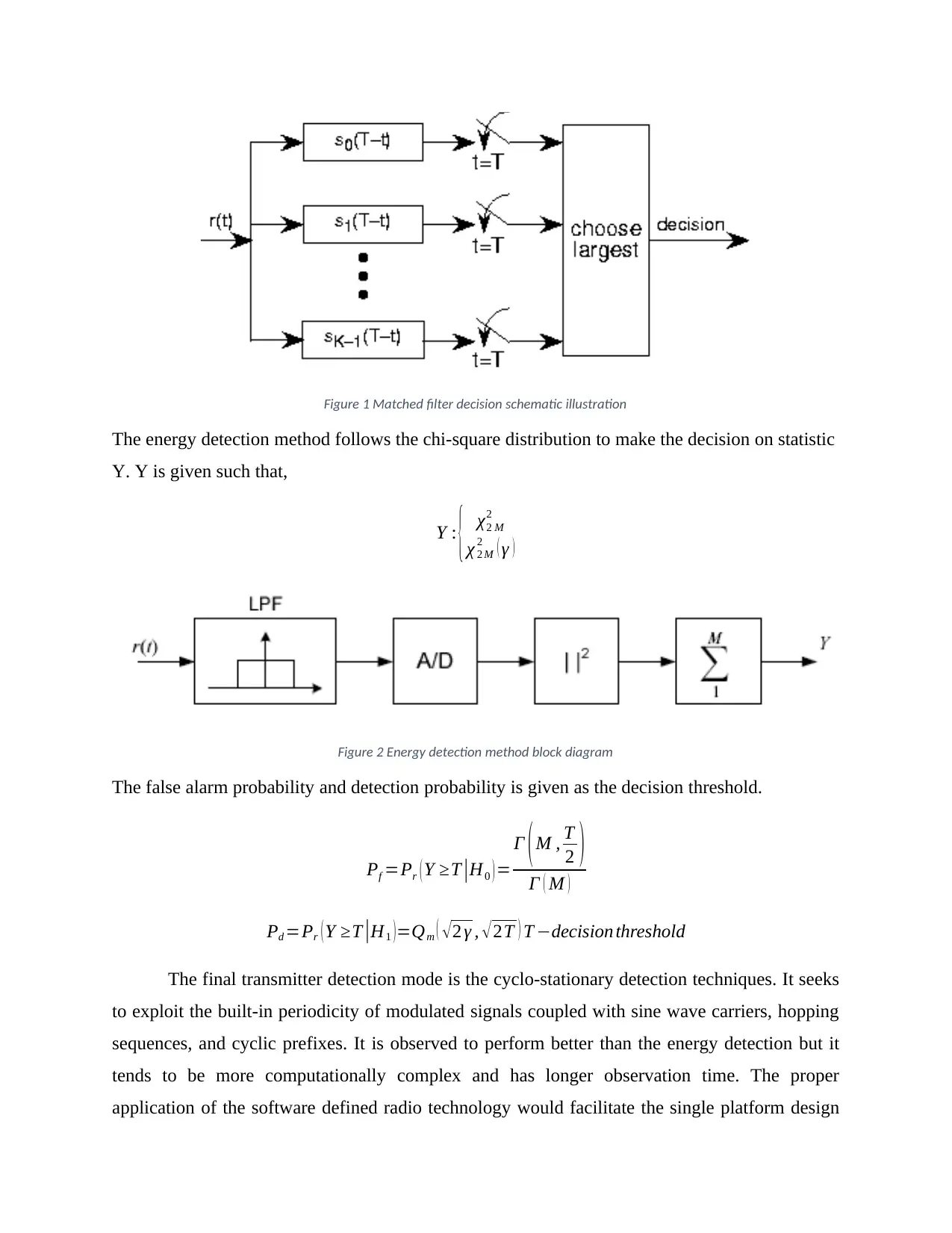
The energy detection method follows the chi-square distribution to make the decision on statistic
Y. Y is given such that,
Y : { χ2 M
2
χ 2 M
2 ( γ )
Figure 2 Energy detection method block diagram
The false alarm probability and detection probability is given as the decision threshold.
Pf =Pr ( Y ≥T |H0 ) =
Γ ( M , T
2 )
Γ ( M )
Pd =Pr ( Y ≥T |H1 ) =Qm ( √ 2 γ , √ 2T ) T −decision threshold
The final transmitter detection mode is the cyclo-stationary detection techniques. It seeks
to exploit the built-in periodicity of modulated signals coupled with sine wave carriers, hopping
sequences, and cyclic prefixes. It is observed to perform better than the energy detection but it
tends to be more computationally complex and has longer observation time. The proper
application of the software defined radio technology would facilitate the single platform design
⊘ This is a preview!⊘
Do you want full access?
Subscribe today to unlock all pages.

Trusted by 1+ million students worldwide
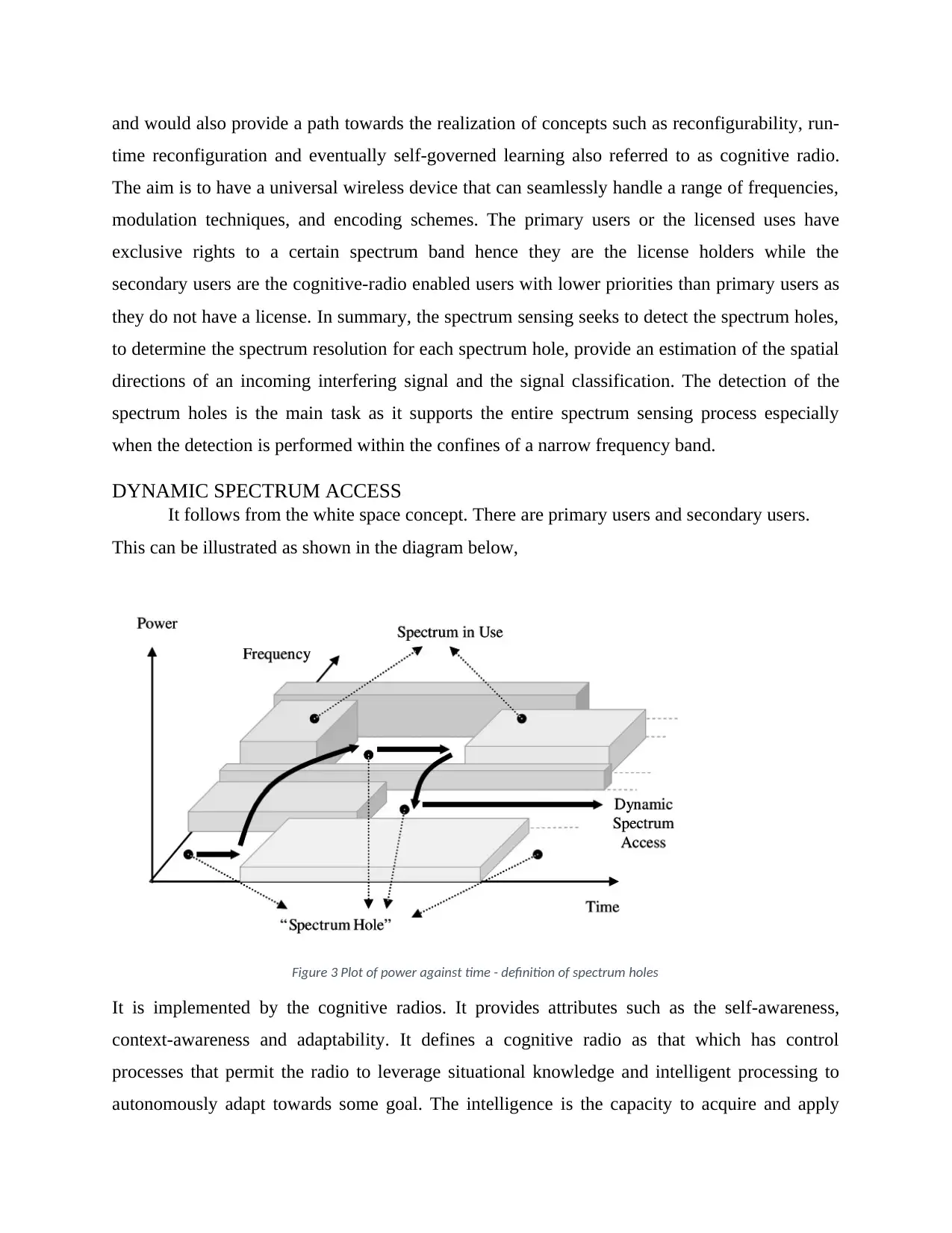
time reconfiguration and eventually self-governed learning also referred to as cognitive radio.
The aim is to have a universal wireless device that can seamlessly handle a range of frequencies,
modulation techniques, and encoding schemes. The primary users or the licensed uses have
exclusive rights to a certain spectrum band hence they are the license holders while the
secondary users are the cognitive-radio enabled users with lower priorities than primary users as
they do not have a license. In summary, the spectrum sensing seeks to detect the spectrum holes,
to determine the spectrum resolution for each spectrum hole, provide an estimation of the spatial
directions of an incoming interfering signal and the signal classification. The detection of the
spectrum holes is the main task as it supports the entire spectrum sensing process especially
when the detection is performed within the confines of a narrow frequency band.
DYNAMIC SPECTRUM ACCESS
It follows from the white space concept. There are primary users and secondary users.
This can be illustrated as shown in the diagram below,
Figure 3 Plot of power against time - definition of spectrum holes
It is implemented by the cognitive radios. It provides attributes such as the self-awareness,
context-awareness and adaptability. It defines a cognitive radio as that which has control
processes that permit the radio to leverage situational knowledge and intelligent processing to
autonomously adapt towards some goal. The intelligence is the capacity to acquire and apply
Paraphrase This Document
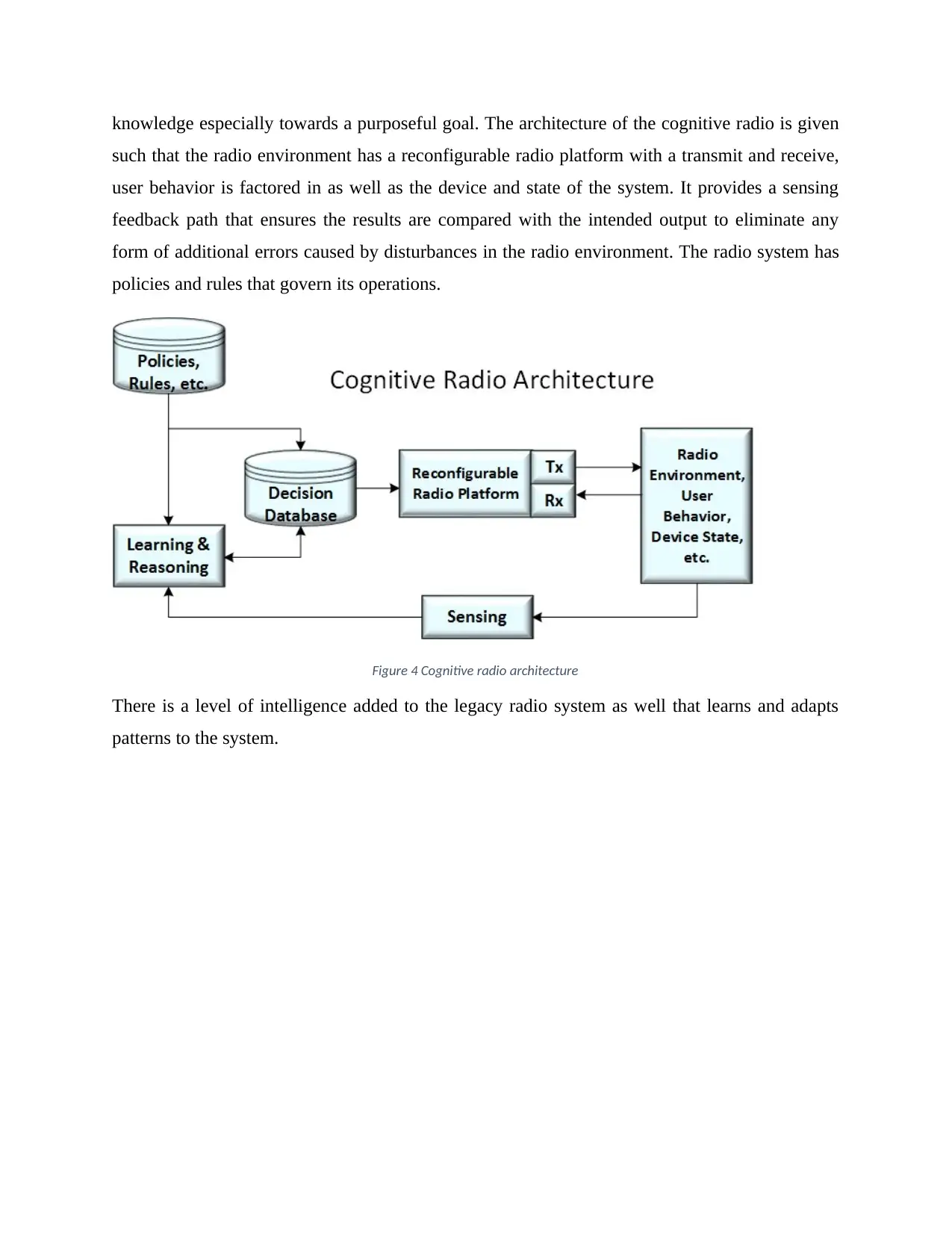
such that the radio environment has a reconfigurable radio platform with a transmit and receive,
user behavior is factored in as well as the device and state of the system. It provides a sensing
feedback path that ensures the results are compared with the intended output to eliminate any
form of additional errors caused by disturbances in the radio environment. The radio system has
policies and rules that govern its operations.
Figure 4 Cognitive radio architecture
There is a level of intelligence added to the legacy radio system as well that learns and adapts
patterns to the system.
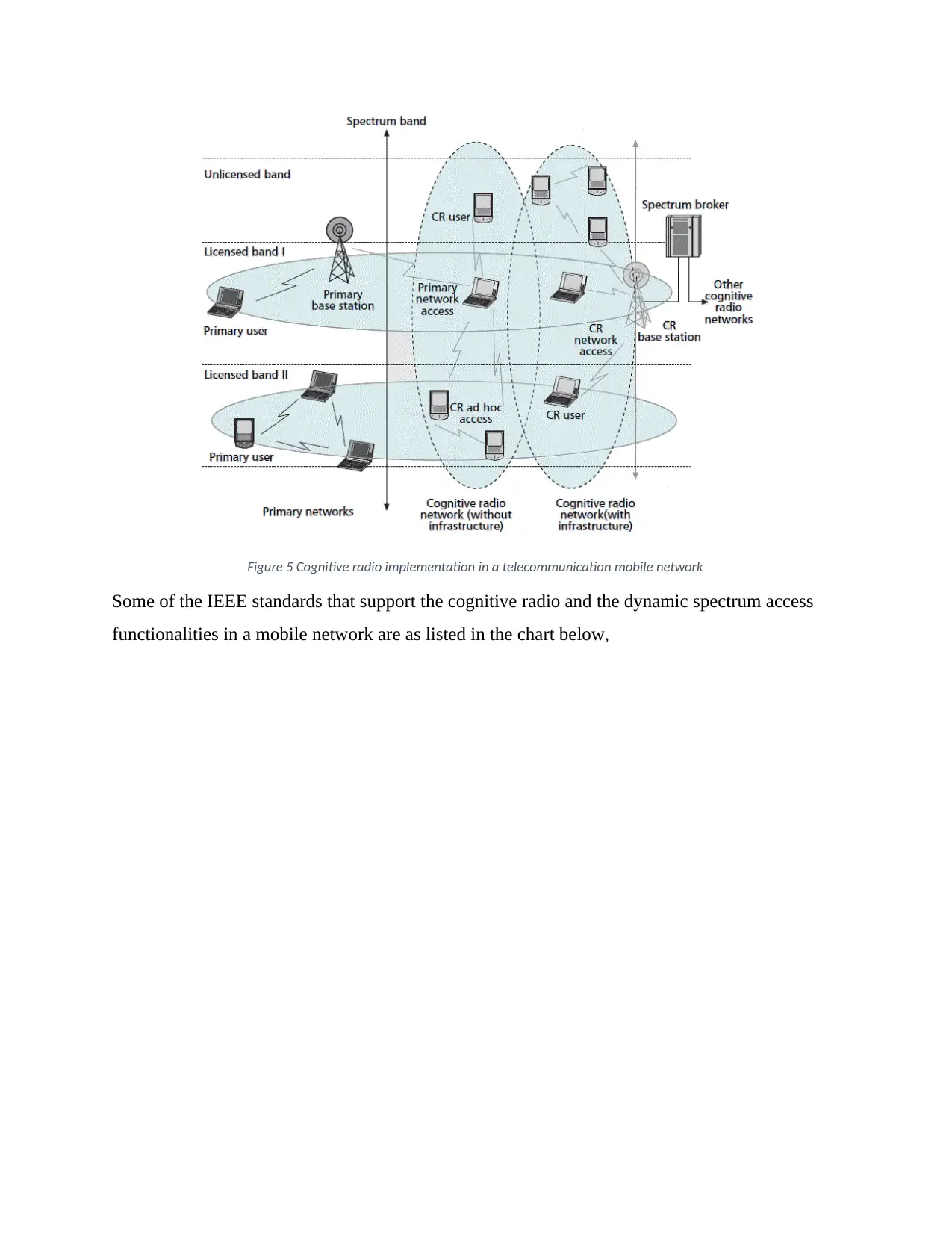
Some of the IEEE standards that support the cognitive radio and the dynamic spectrum access
functionalities in a mobile network are as listed in the chart below,
⊘ This is a preview!⊘
Do you want full access?
Subscribe today to unlock all pages.

Trusted by 1+ million students worldwide
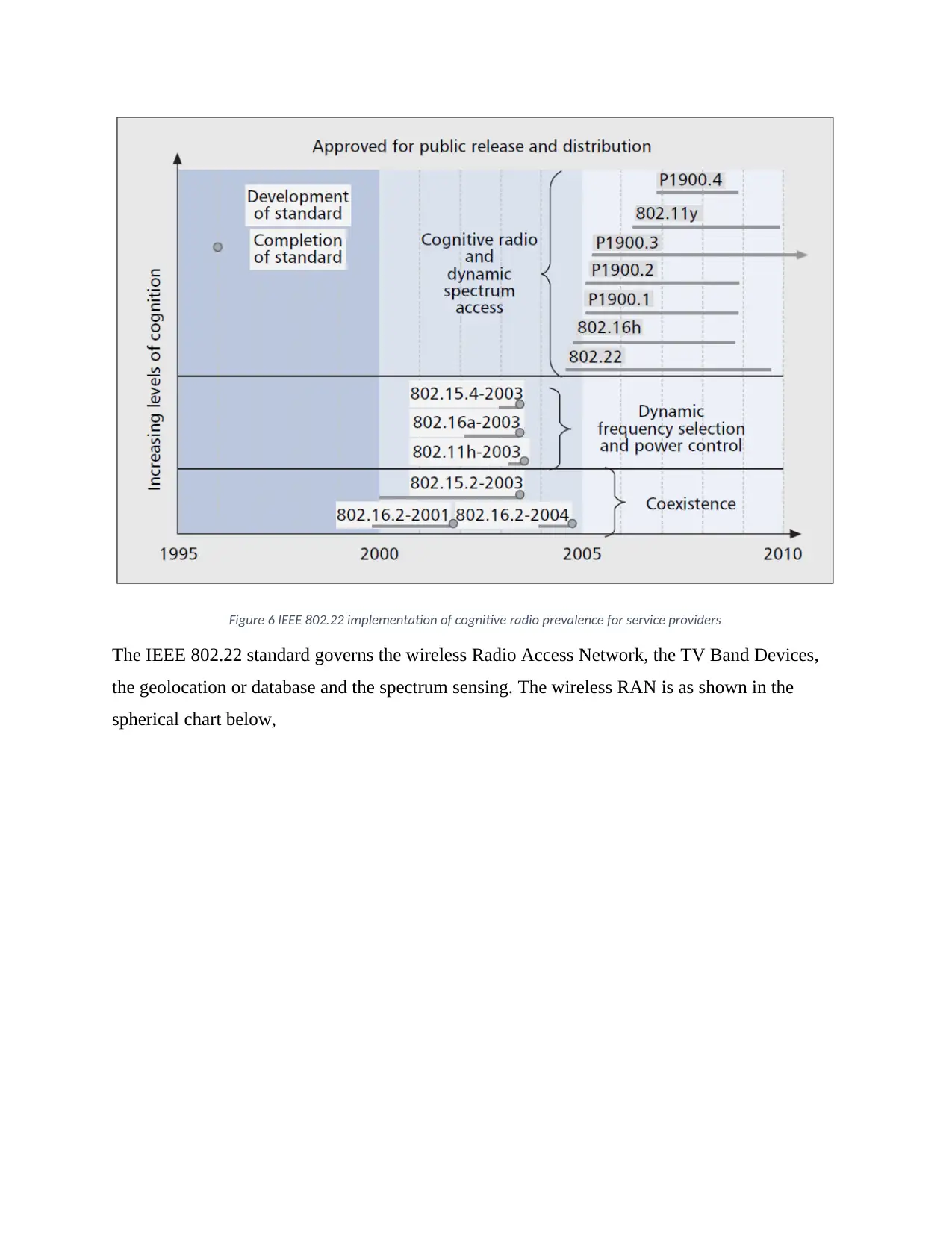
The IEEE 802.22 standard governs the wireless Radio Access Network, the TV Band Devices,
the geolocation or database and the spectrum sensing. The wireless RAN is as shown in the
spherical chart below,
Paraphrase This Document
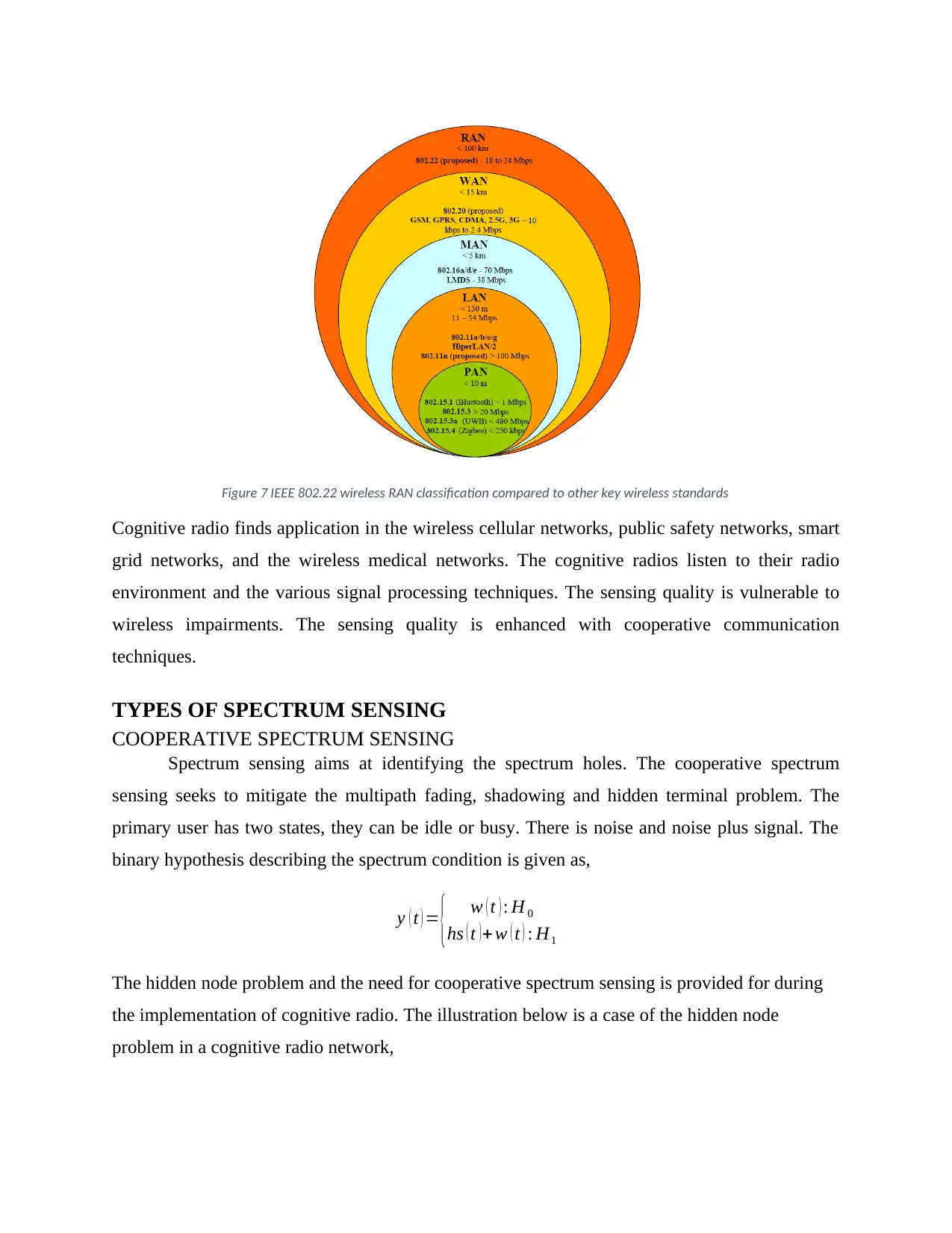
Cognitive radio finds application in the wireless cellular networks, public safety networks, smart
grid networks, and the wireless medical networks. The cognitive radios listen to their radio
environment and the various signal processing techniques. The sensing quality is vulnerable to
wireless impairments. The sensing quality is enhanced with cooperative communication
techniques.
TYPES OF SPECTRUM SENSING
COOPERATIVE SPECTRUM SENSING
Spectrum sensing aims at identifying the spectrum holes. The cooperative spectrum
sensing seeks to mitigate the multipath fading, shadowing and hidden terminal problem. The
primary user has two states, they can be idle or busy. There is noise and noise plus signal. The
binary hypothesis describing the spectrum condition is given as,
y ( t ) = { w ( t ) : H 0
hs ( t ) + w ( t ) : Η1
The hidden node problem and the need for cooperative spectrum sensing is provided for during
the implementation of cognitive radio. The illustration below is a case of the hidden node
problem in a cognitive radio network,
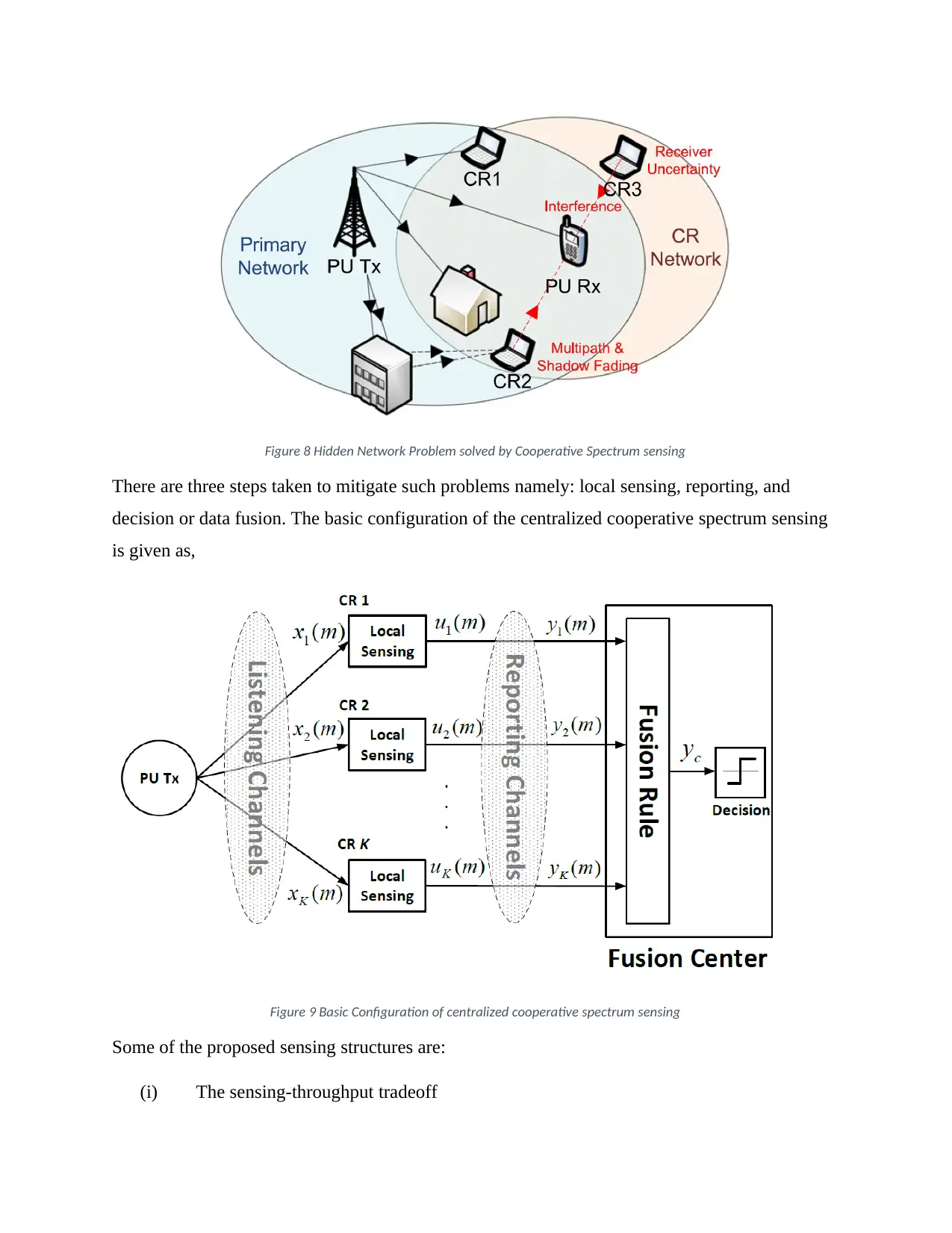
There are three steps taken to mitigate such problems namely: local sensing, reporting, and
decision or data fusion. The basic configuration of the centralized cooperative spectrum sensing
is given as,
Figure 9 Basic Configuration of centralized cooperative spectrum sensing
Some of the proposed sensing structures are:
(i) The sensing-throughput tradeoff
⊘ This is a preview!⊘
Do you want full access?
Subscribe today to unlock all pages.

Trusted by 1+ million students worldwide
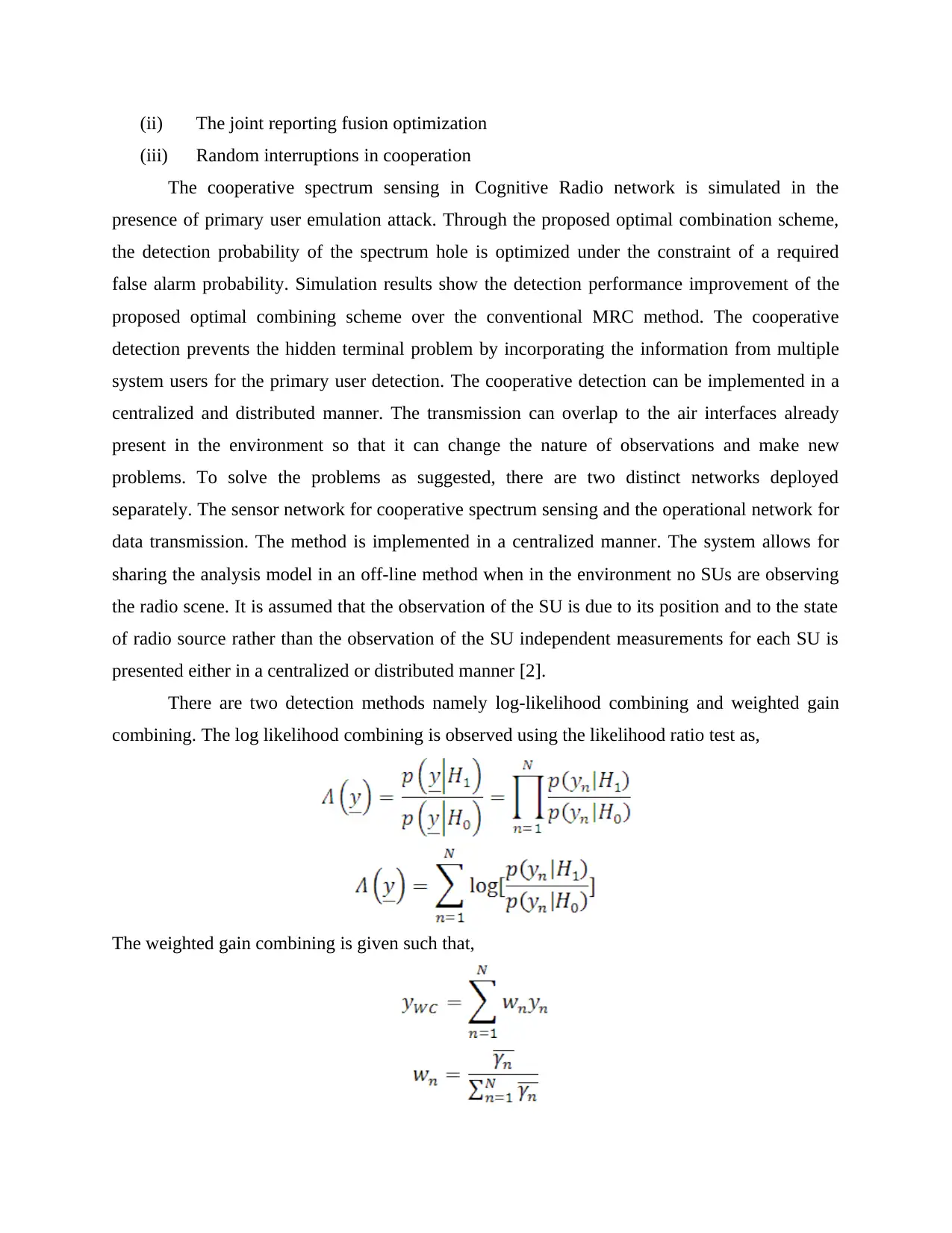
(iii) Random interruptions in cooperation
The cooperative spectrum sensing in Cognitive Radio network is simulated in the
presence of primary user emulation attack. Through the proposed optimal combination scheme,
the detection probability of the spectrum hole is optimized under the constraint of a required
false alarm probability. Simulation results show the detection performance improvement of the
proposed optimal combining scheme over the conventional MRC method. The cooperative
detection prevents the hidden terminal problem by incorporating the information from multiple
system users for the primary user detection. The cooperative detection can be implemented in a
centralized and distributed manner. The transmission can overlap to the air interfaces already
present in the environment so that it can change the nature of observations and make new
problems. To solve the problems as suggested, there are two distinct networks deployed
separately. The sensor network for cooperative spectrum sensing and the operational network for
data transmission. The method is implemented in a centralized manner. The system allows for
sharing the analysis model in an off-line method when in the environment no SUs are observing
the radio scene. It is assumed that the observation of the SU is due to its position and to the state
of radio source rather than the observation of the SU independent measurements for each SU is
presented either in a centralized or distributed manner [2].
There are two detection methods namely log-likelihood combining and weighted gain
combining. The log likelihood combining is observed using the likelihood ratio test as,
The weighted gain combining is given such that,
Paraphrase This Document
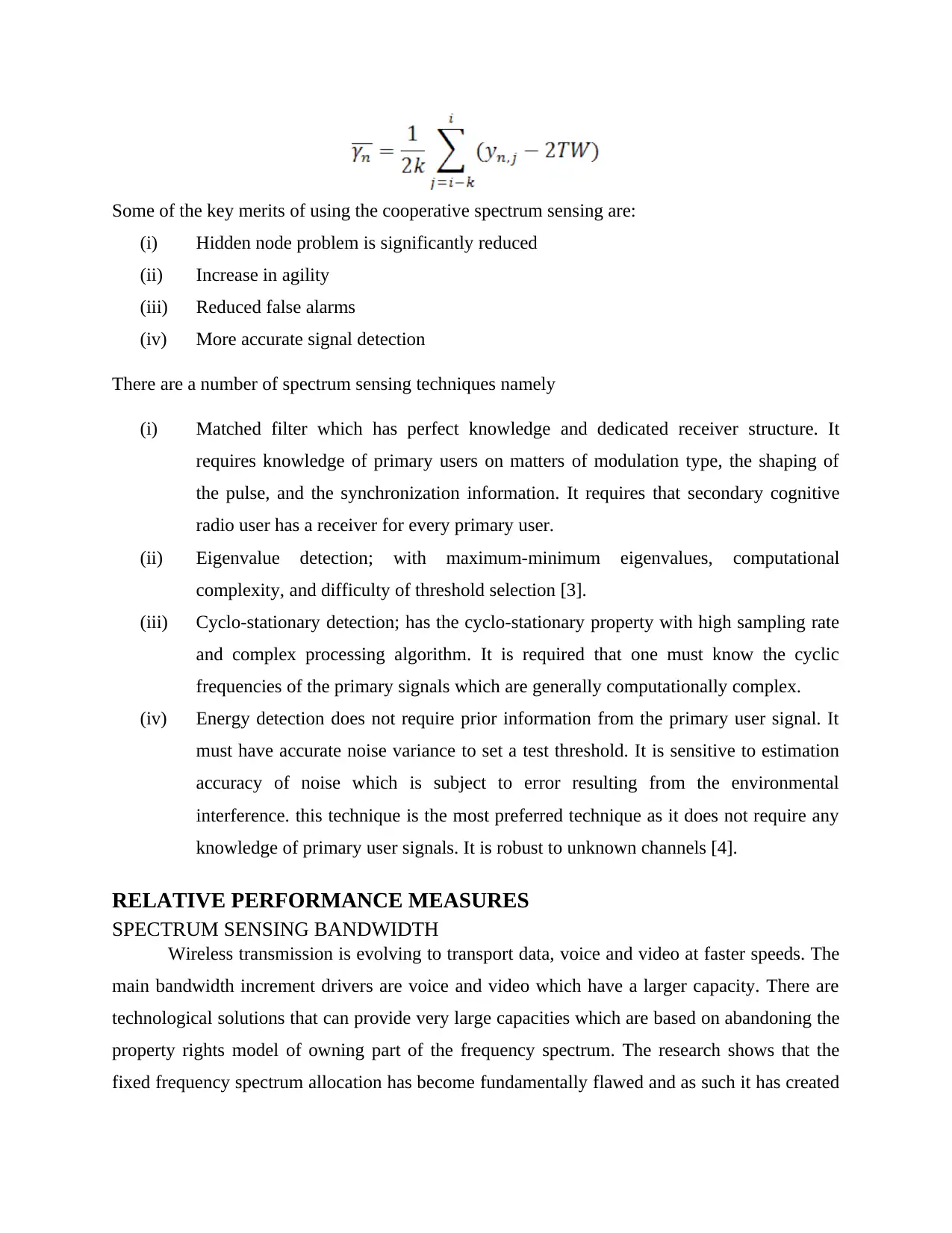
(i) Hidden node problem is significantly reduced
(ii) Increase in agility
(iii) Reduced false alarms
(iv) More accurate signal detection
There are a number of spectrum sensing techniques namely
(i) Matched filter which has perfect knowledge and dedicated receiver structure. It
requires knowledge of primary users on matters of modulation type, the shaping of
the pulse, and the synchronization information. It requires that secondary cognitive
radio user has a receiver for every primary user.
(ii) Eigenvalue detection; with maximum-minimum eigenvalues, computational
complexity, and difficulty of threshold selection [3].
(iii) Cyclo-stationary detection; has the cyclo-stationary property with high sampling rate
and complex processing algorithm. It is required that one must know the cyclic
frequencies of the primary signals which are generally computationally complex.
(iv) Energy detection does not require prior information from the primary user signal. It
must have accurate noise variance to set a test threshold. It is sensitive to estimation
accuracy of noise which is subject to error resulting from the environmental
interference. this technique is the most preferred technique as it does not require any
knowledge of primary user signals. It is robust to unknown channels [4].
RELATIVE PERFORMANCE MEASURES
SPECTRUM SENSING BANDWIDTH
Wireless transmission is evolving to transport data, voice and video at faster speeds. The
main bandwidth increment drivers are voice and video which have a larger capacity. There are
technological solutions that can provide very large capacities which are based on abandoning the
property rights model of owning part of the frequency spectrum. The research shows that the
fixed frequency spectrum allocation has become fundamentally flawed and as such it has created
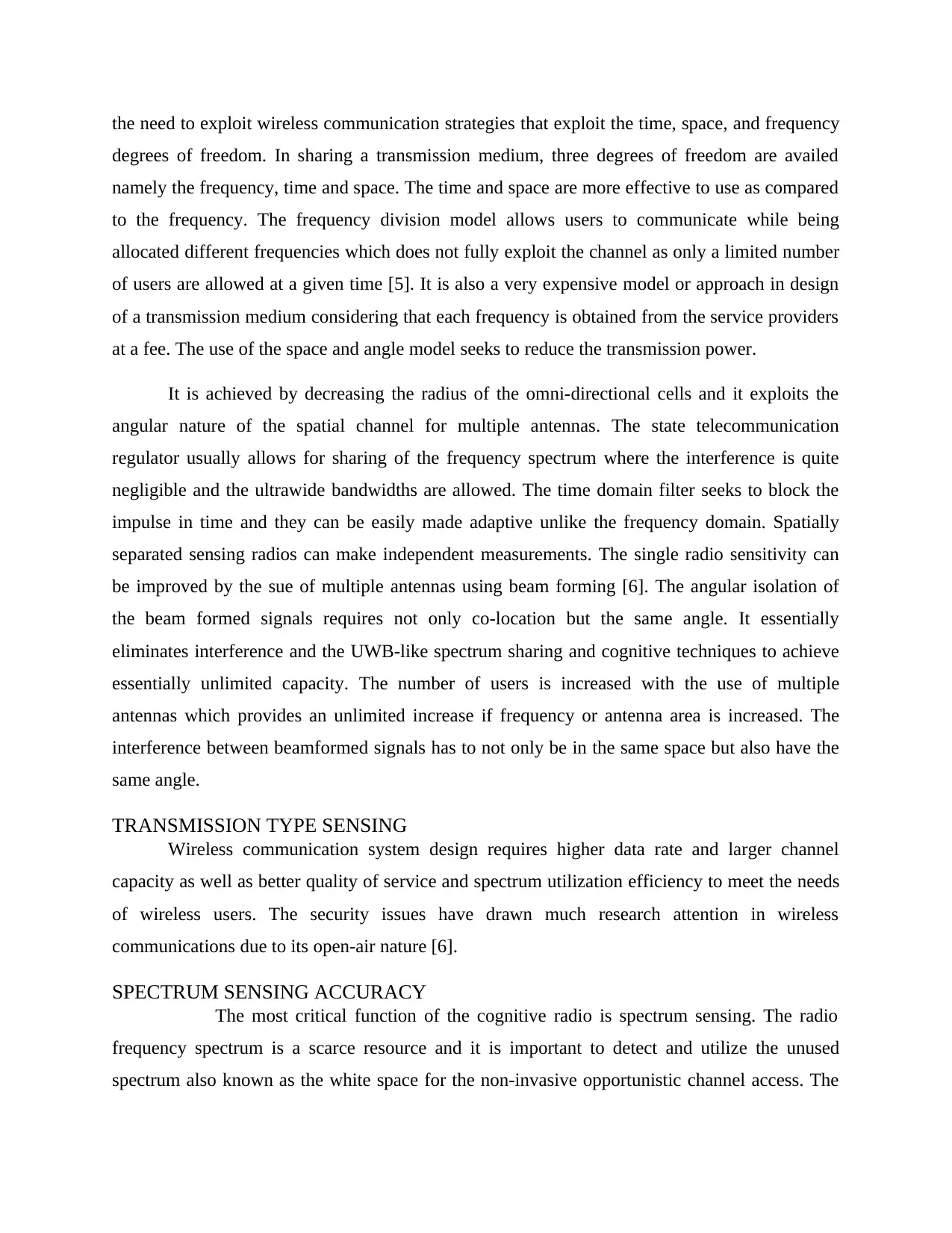
degrees of freedom. In sharing a transmission medium, three degrees of freedom are availed
namely the frequency, time and space. The time and space are more effective to use as compared
to the frequency. The frequency division model allows users to communicate while being
allocated different frequencies which does not fully exploit the channel as only a limited number
of users are allowed at a given time [5]. It is also a very expensive model or approach in design
of a transmission medium considering that each frequency is obtained from the service providers
at a fee. The use of the space and angle model seeks to reduce the transmission power.
It is achieved by decreasing the radius of the omni-directional cells and it exploits the
angular nature of the spatial channel for multiple antennas. The state telecommunication
regulator usually allows for sharing of the frequency spectrum where the interference is quite
negligible and the ultrawide bandwidths are allowed. The time domain filter seeks to block the
impulse in time and they can be easily made adaptive unlike the frequency domain. Spatially
separated sensing radios can make independent measurements. The single radio sensitivity can
be improved by the sue of multiple antennas using beam forming [6]. The angular isolation of
the beam formed signals requires not only co-location but the same angle. It essentially
eliminates interference and the UWB-like spectrum sharing and cognitive techniques to achieve
essentially unlimited capacity. The number of users is increased with the use of multiple
antennas which provides an unlimited increase if frequency or antenna area is increased. The
interference between beamformed signals has to not only be in the same space but also have the
same angle.
TRANSMISSION TYPE SENSING
Wireless communication system design requires higher data rate and larger channel
capacity as well as better quality of service and spectrum utilization efficiency to meet the needs
of wireless users. The security issues have drawn much research attention in wireless
communications due to its open-air nature [6].
SPECTRUM SENSING ACCURACY
The most critical function of the cognitive radio is spectrum sensing. The radio
frequency spectrum is a scarce resource and it is important to detect and utilize the unused
spectrum also known as the white space for the non-invasive opportunistic channel access. The
⊘ This is a preview!⊘
Do you want full access?
Subscribe today to unlock all pages.

Trusted by 1+ million students worldwide
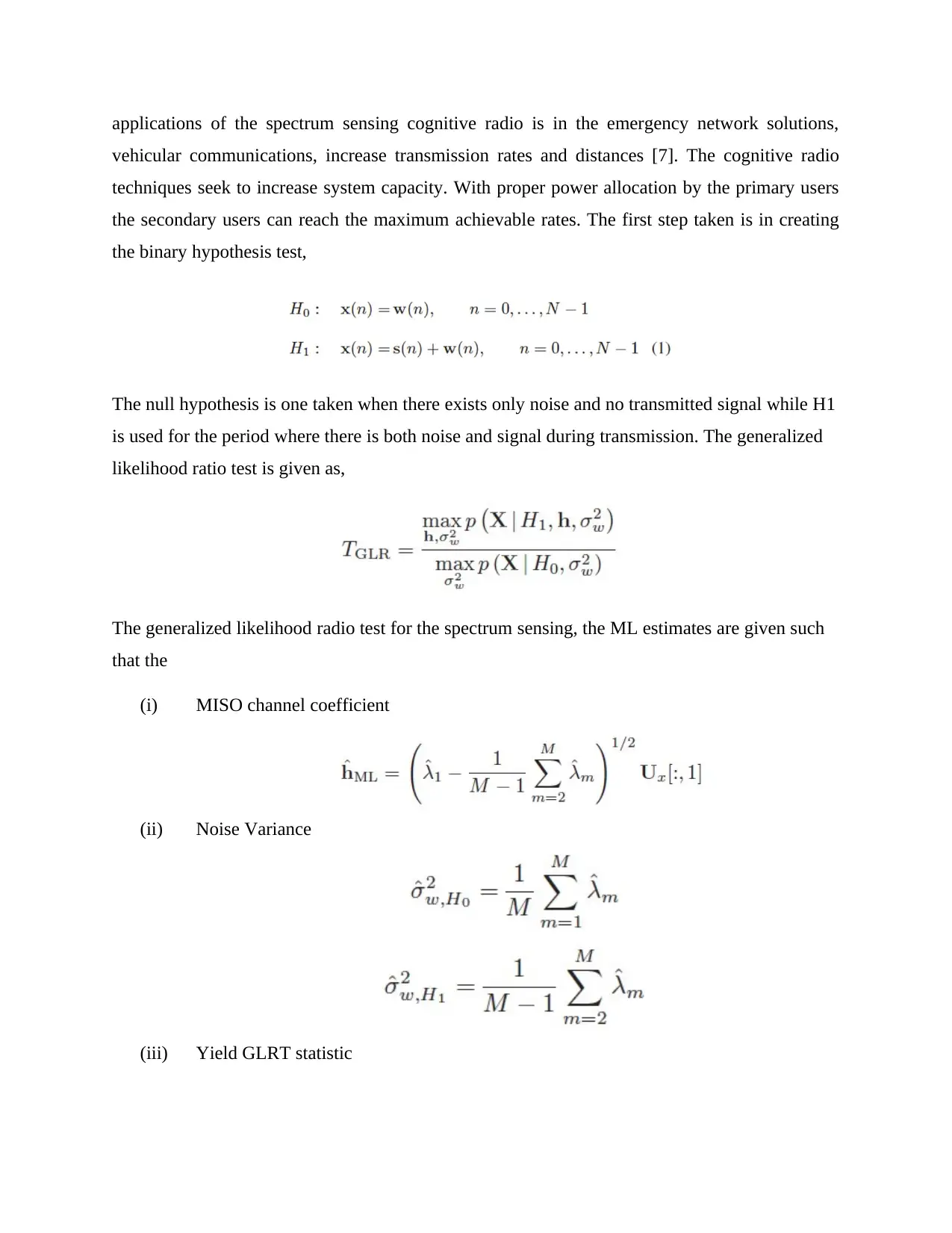
vehicular communications, increase transmission rates and distances [7]. The cognitive radio
techniques seek to increase system capacity. With proper power allocation by the primary users
the secondary users can reach the maximum achievable rates. The first step taken is in creating
the binary hypothesis test,
The null hypothesis is one taken when there exists only noise and no transmitted signal while H1
is used for the period where there is both noise and signal during transmission. The generalized
likelihood ratio test is given as,
The generalized likelihood radio test for the spectrum sensing, the ML estimates are given such
that the
(i) MISO channel coefficient
(ii) Noise Variance
(iii) Yield GLRT statistic
Paraphrase This Document
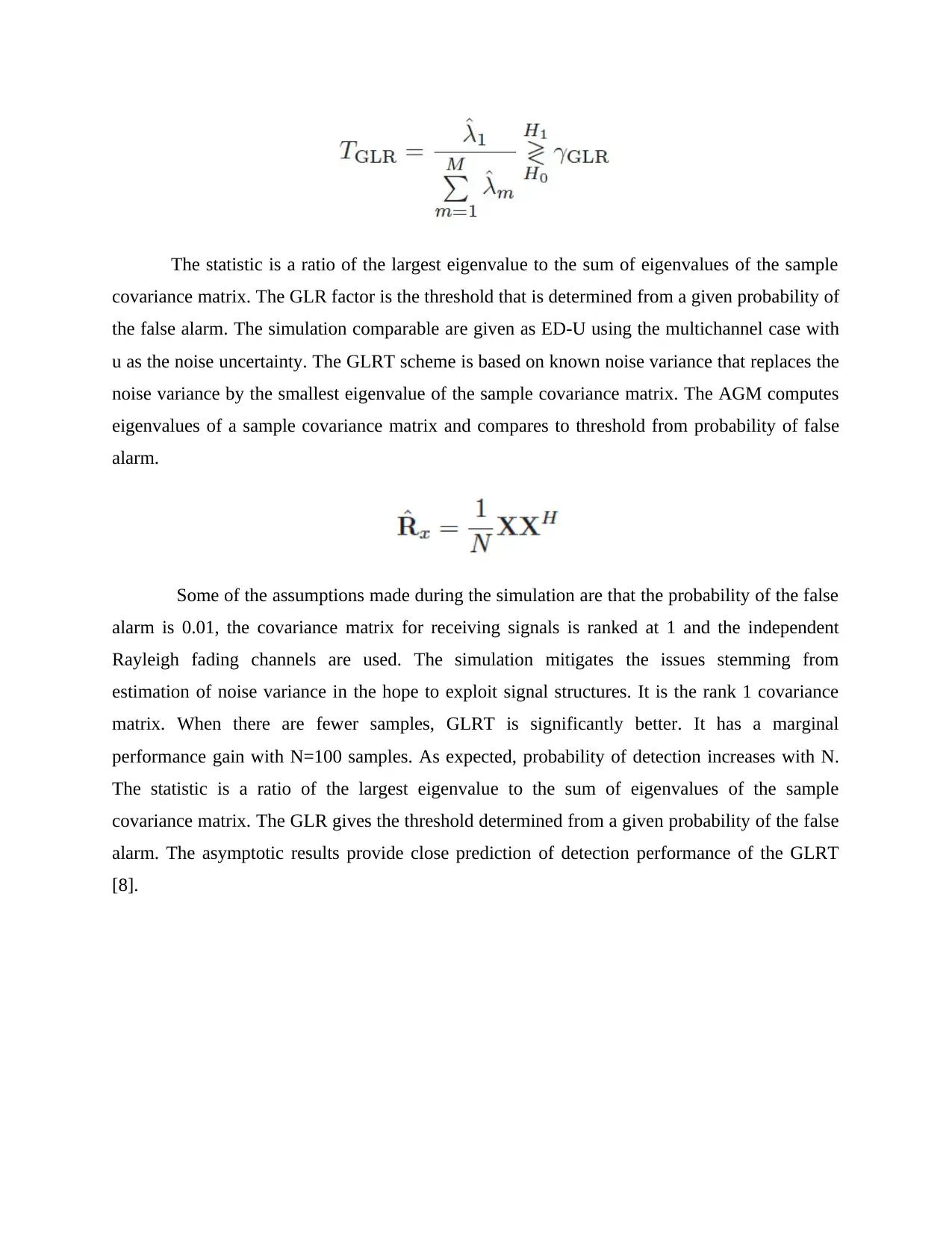
covariance matrix. The GLR factor is the threshold that is determined from a given probability of
the false alarm. The simulation comparable are given as ED-U using the multichannel case with
u as the noise uncertainty. The GLRT scheme is based on known noise variance that replaces the
noise variance by the smallest eigenvalue of the sample covariance matrix. The AGM computes
eigenvalues of a sample covariance matrix and compares to threshold from probability of false
alarm.
Some of the assumptions made during the simulation are that the probability of the false
alarm is 0.01, the covariance matrix for receiving signals is ranked at 1 and the independent
Rayleigh fading channels are used. The simulation mitigates the issues stemming from
estimation of noise variance in the hope to exploit signal structures. It is the rank 1 covariance
matrix. When there are fewer samples, GLRT is significantly better. It has a marginal
performance gain with N=100 samples. As expected, probability of detection increases with N.
The statistic is a ratio of the largest eigenvalue to the sum of eigenvalues of the sample
covariance matrix. The GLR gives the threshold determined from a given probability of the false
alarm. The asymptotic results provide close prediction of detection performance of the GLRT
[8].
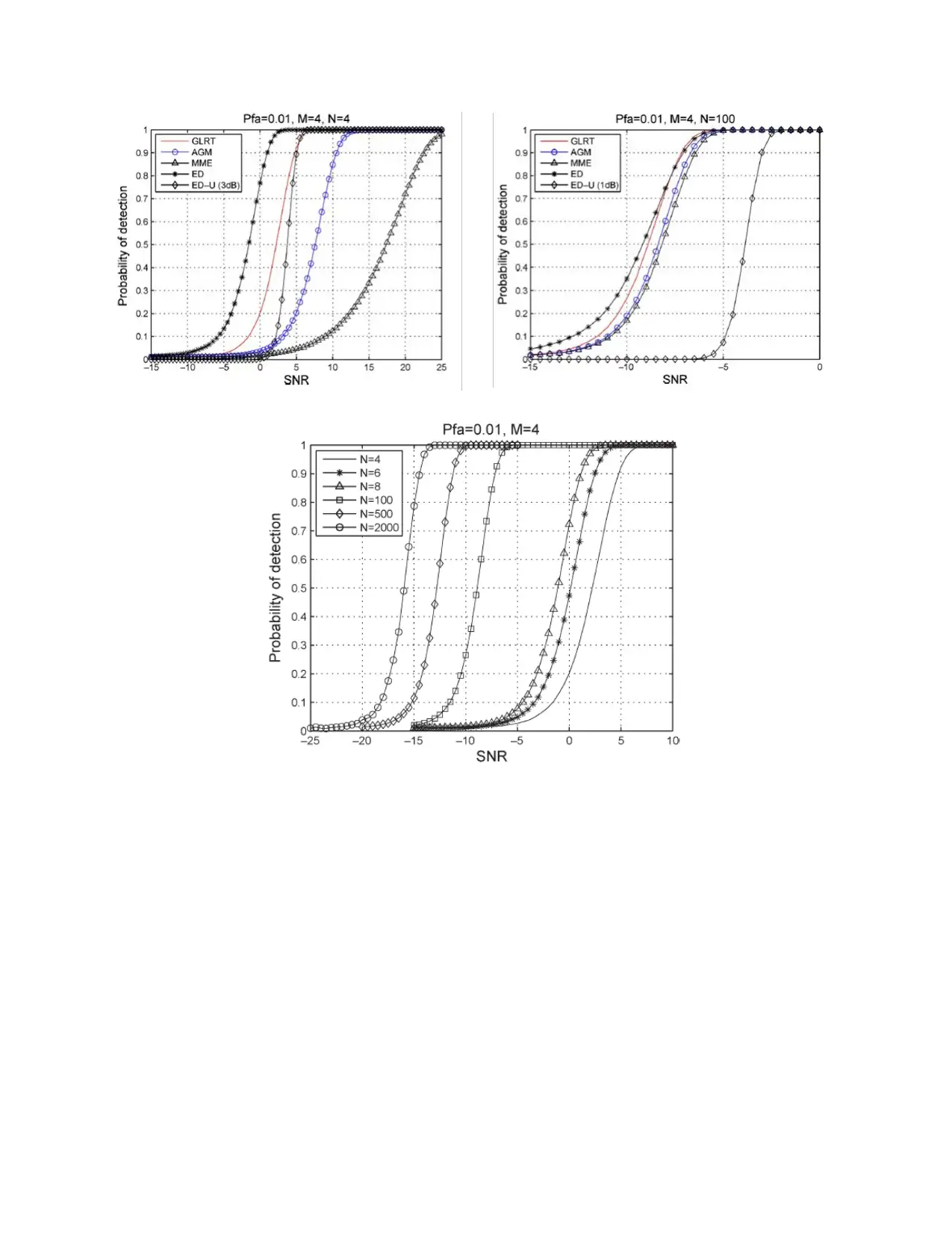
⊘ This is a preview!⊘
Do you want full access?
Subscribe today to unlock all pages.

Trusted by 1+ million students worldwide
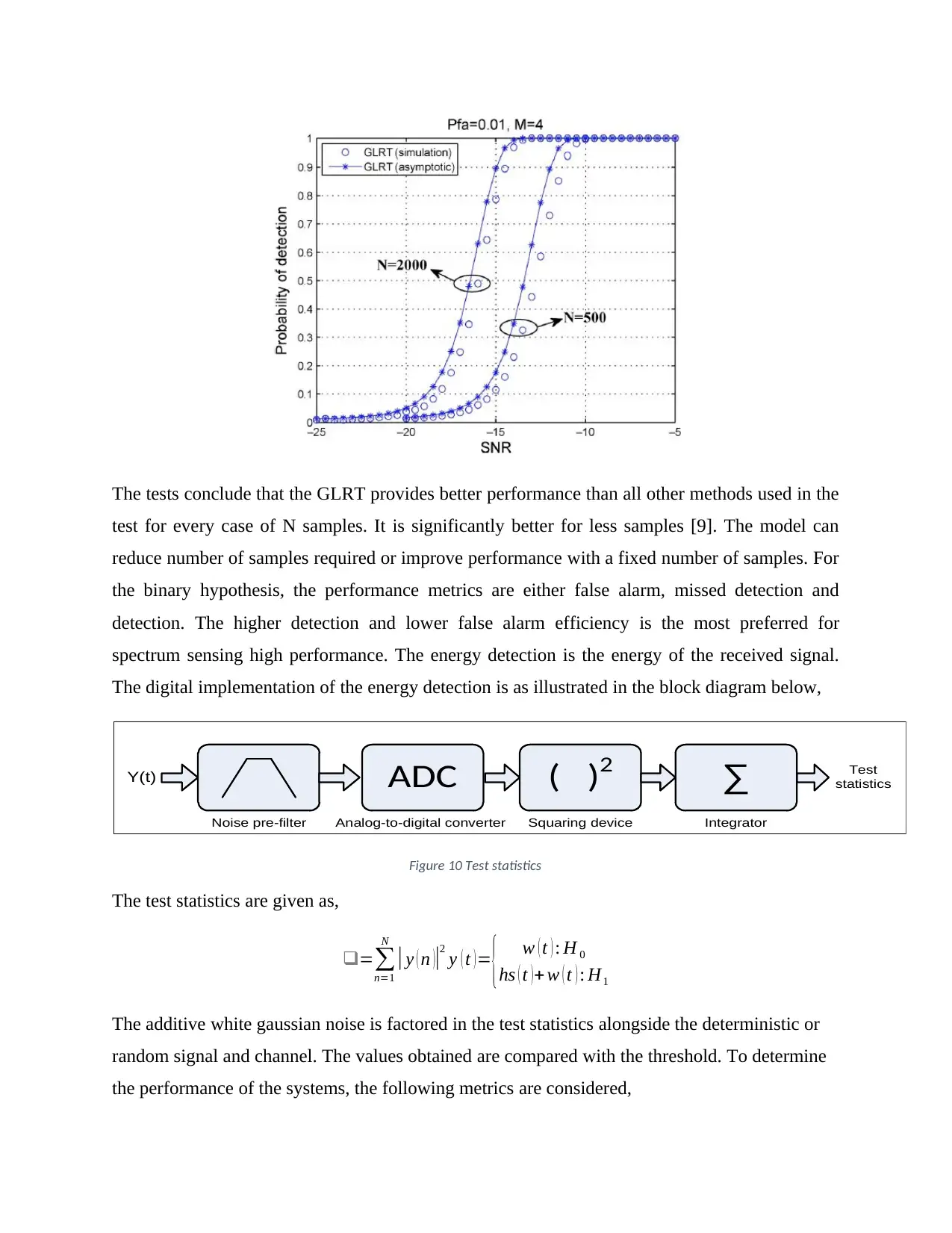
test for every case of N samples. It is significantly better for less samples [9]. The model can
reduce number of samples required or improve performance with a fixed number of samples. For
the binary hypothesis, the performance metrics are either false alarm, missed detection and
detection. The higher detection and lower false alarm efficiency is the most preferred for
spectrum sensing high performance. The energy detection is the energy of the received signal.
The digital implementation of the energy detection is as illustrated in the block diagram below,
( ) 2
Noise pre-filter Squaring device Integrator
Test
statistics
Y(t) ∑ADC
Analog-to-digital converter
Figure 10 Test statistics
The test statistics are given as,
❑=∑
n=1
N
| y ( n )|2
y ( t )= { w ( t ) : H 0
hs ( t )+ w ( t ) : Η1
The additive white gaussian noise is factored in the test statistics alongside the deterministic or
random signal and channel. The values obtained are compared with the threshold. To determine
the performance of the systems, the following metrics are considered,
Paraphrase This Document
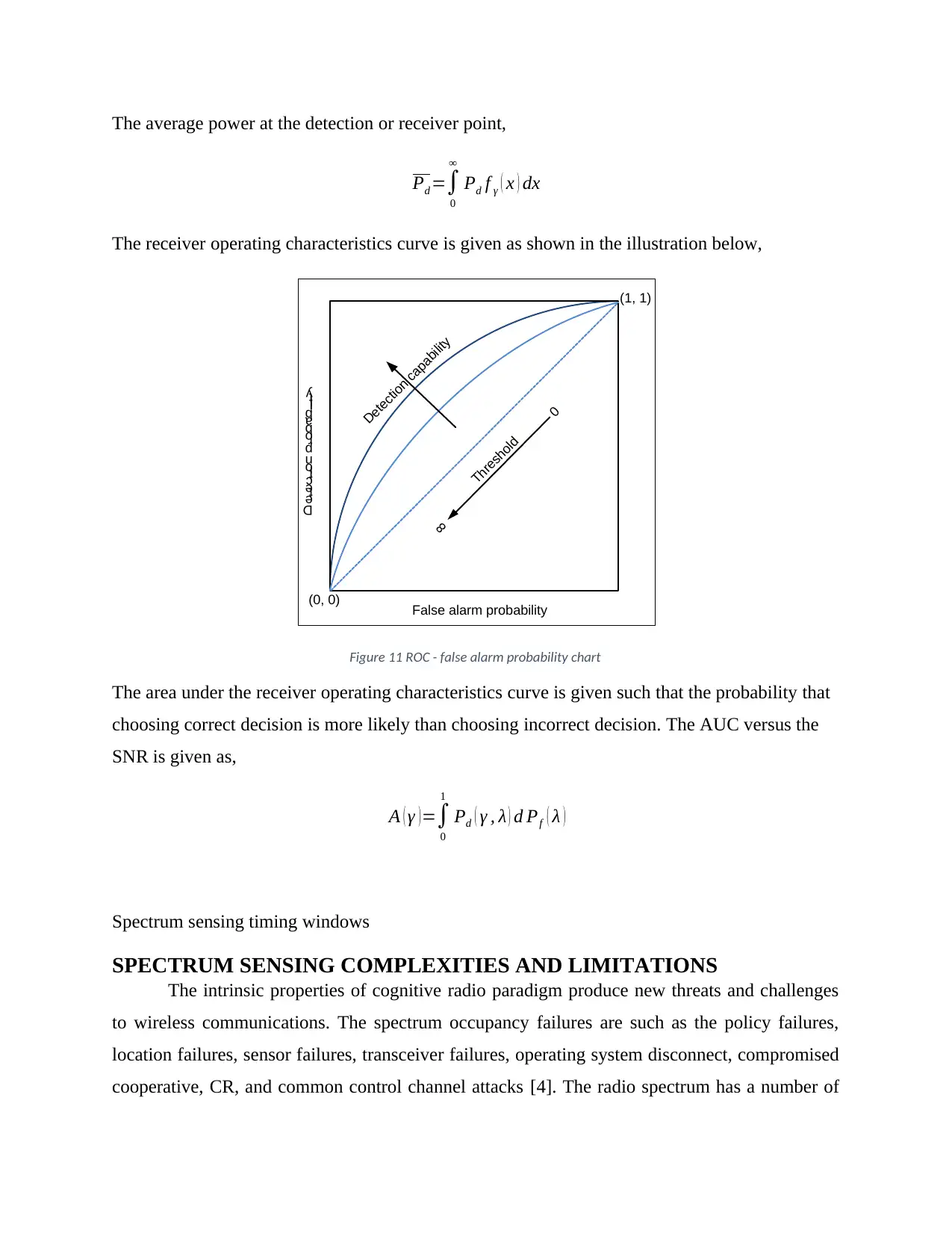
Pd =∫
0
∞
Pd f γ ( x ) dx
The receiver operating characteristics curve is given as shown in the illustration below,
(1, 1)
False alarm probability
D
e
te
c
tio
n
p
ro
b
a
b
ility
(0, 0)
Threshold 0
8
Detection capability
Figure 11 ROC - false alarm probability chart
The area under the receiver operating characteristics curve is given such that the probability that
choosing correct decision is more likely than choosing incorrect decision. The AUC versus the
SNR is given as,
A ( γ )=∫
0
1
Pd ( γ , λ ) d Pf ( λ )
Spectrum sensing timing windows
SPECTRUM SENSING COMPLEXITIES AND LIMITATIONS
The intrinsic properties of cognitive radio paradigm produce new threats and challenges
to wireless communications. The spectrum occupancy failures are such as the policy failures,
location failures, sensor failures, transceiver failures, operating system disconnect, compromised
cooperative, CR, and common control channel attacks [4]. The radio spectrum has a number of
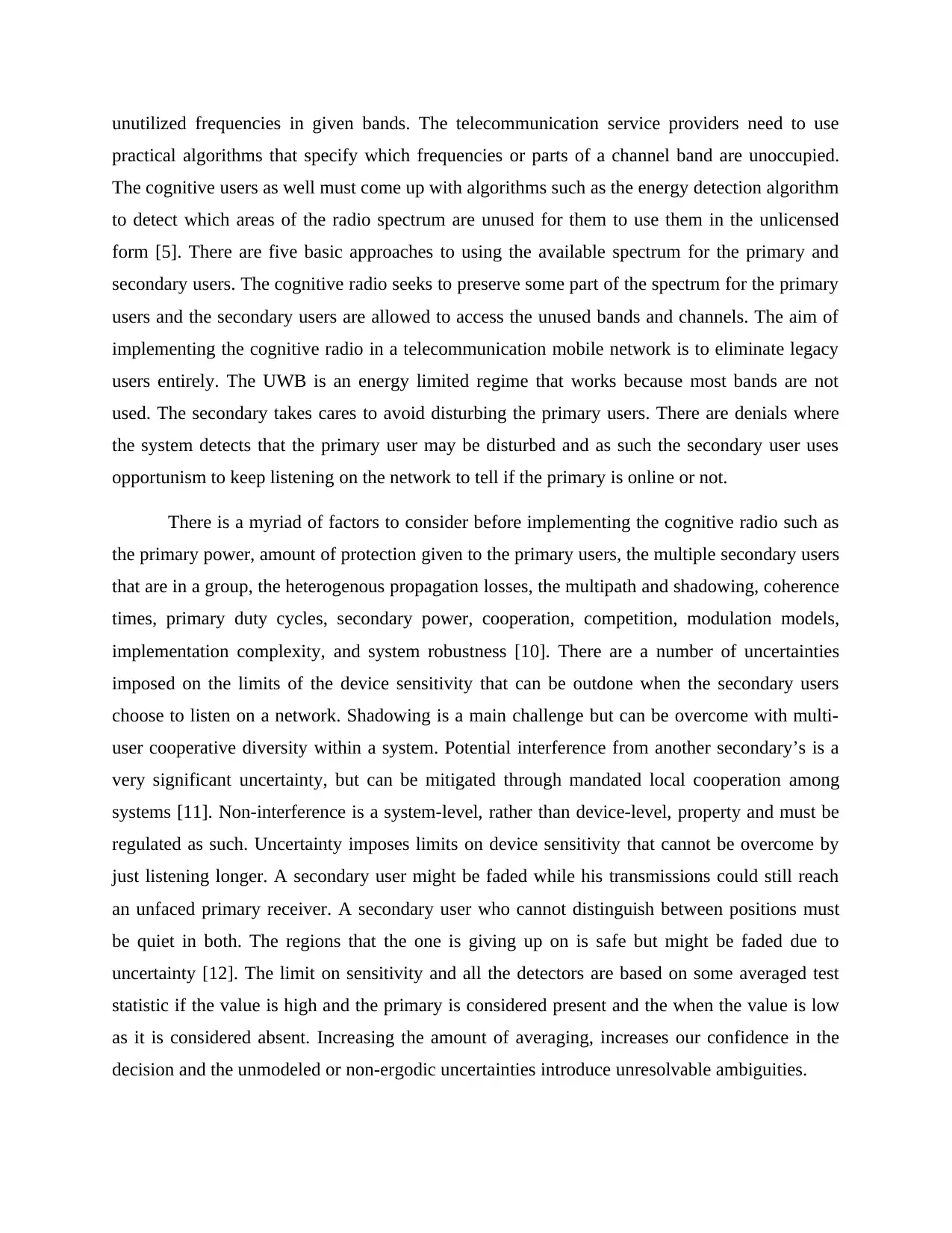
practical algorithms that specify which frequencies or parts of a channel band are unoccupied.
The cognitive users as well must come up with algorithms such as the energy detection algorithm
to detect which areas of the radio spectrum are unused for them to use them in the unlicensed
form [5]. There are five basic approaches to using the available spectrum for the primary and
secondary users. The cognitive radio seeks to preserve some part of the spectrum for the primary
users and the secondary users are allowed to access the unused bands and channels. The aim of
implementing the cognitive radio in a telecommunication mobile network is to eliminate legacy
users entirely. The UWB is an energy limited regime that works because most bands are not
used. The secondary takes cares to avoid disturbing the primary users. There are denials where
the system detects that the primary user may be disturbed and as such the secondary user uses
opportunism to keep listening on the network to tell if the primary is online or not.
There is a myriad of factors to consider before implementing the cognitive radio such as
the primary power, amount of protection given to the primary users, the multiple secondary users
that are in a group, the heterogenous propagation losses, the multipath and shadowing, coherence
times, primary duty cycles, secondary power, cooperation, competition, modulation models,
implementation complexity, and system robustness [10]. There are a number of uncertainties
imposed on the limits of the device sensitivity that can be outdone when the secondary users
choose to listen on a network. Shadowing is a main challenge but can be overcome with multi-
user cooperative diversity within a system. Potential interference from another secondary’s is a
very significant uncertainty, but can be mitigated through mandated local cooperation among
systems [11]. Non-interference is a system-level, rather than device-level, property and must be
regulated as such. Uncertainty imposes limits on device sensitivity that cannot be overcome by
just listening longer. A secondary user might be faded while his transmissions could still reach
an unfaced primary receiver. A secondary user who cannot distinguish between positions must
be quiet in both. The regions that the one is giving up on is safe but might be faded due to
uncertainty [12]. The limit on sensitivity and all the detectors are based on some averaged test
statistic if the value is high and the primary is considered present and the when the value is low
as it is considered absent. Increasing the amount of averaging, increases our confidence in the
decision and the unmodeled or non-ergodic uncertainties introduce unresolvable ambiguities.
⊘ This is a preview!⊘
Do you want full access?
Subscribe today to unlock all pages.

Trusted by 1+ million students worldwide

More potential secondary users to keep quiet in the near vicinity of primary receivers [13]. The
challenge of aggregate interference where one secondary user might be acceptable though there
are millions who would be limited on power density and the slower effective attenuation with
distance. Secondary users should not confuse the uncertain aggregate interference with the
primary signal. The nearby secondary users need to be very quiet during the detection phase.
There is an increasing density of secondary transmission that requires more cooperation. The
caveats are studied based on the classical link budget [14]. For reliable communication at a given
range within a given bandwidth the signal to noise ration of a signal is given as,
The coding gain is bounded by channel capacity and the additional margins are needed to deal
with uncertainty. The cognitive radio seeks to ensure that the secondary users do not interfere
with primary users. This is achieved by setting a limit on the tolerable out-of-system interference
and translates to a limit on maximum power and not minimum power. The cognitive radio
Paraphrase This Document
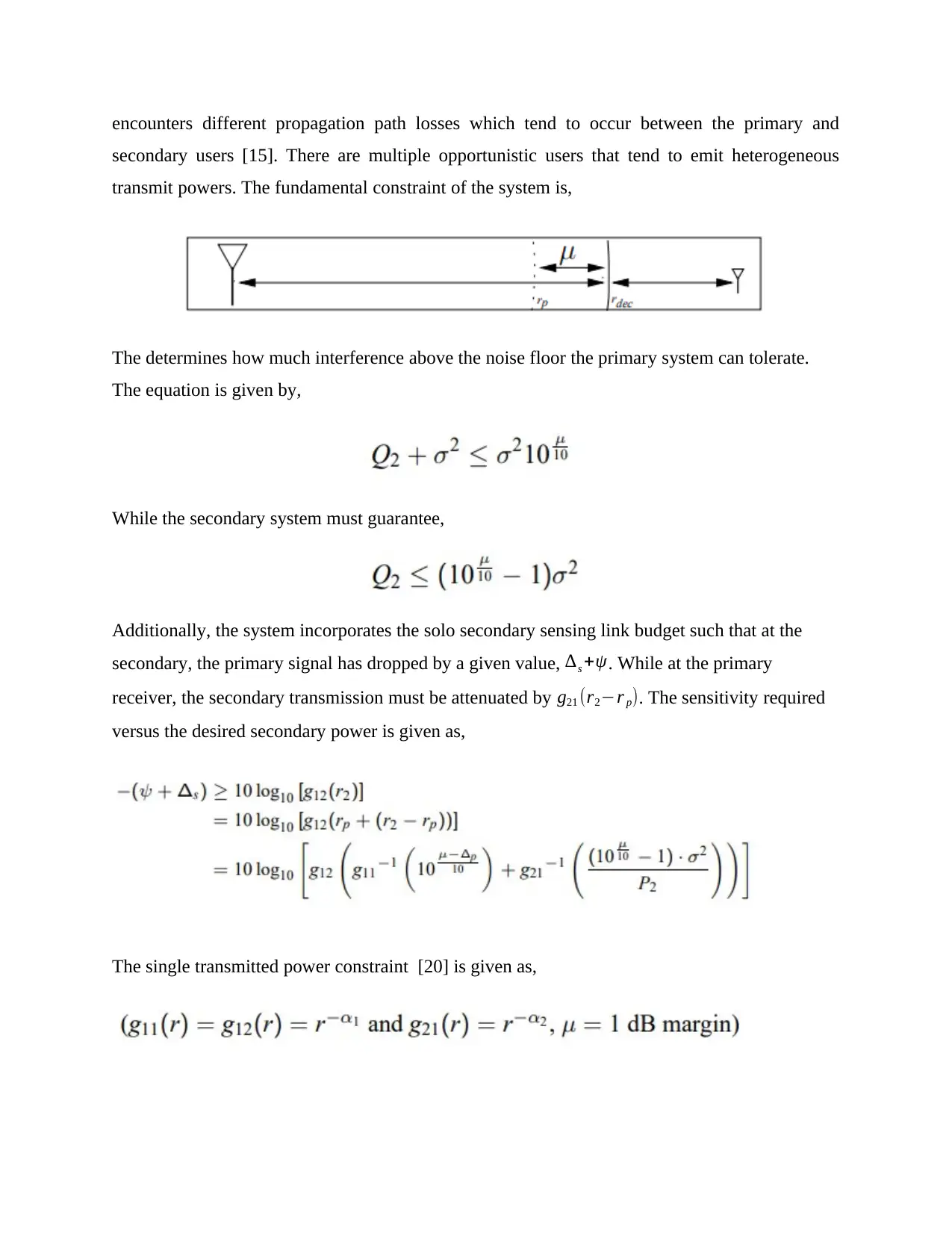
secondary users [15]. There are multiple opportunistic users that tend to emit heterogeneous
transmit powers. The fundamental constraint of the system is,
The determines how much interference above the noise floor the primary system can tolerate.
The equation is given by,
While the secondary system must guarantee,
Additionally, the system incorporates the solo secondary sensing link budget such that at the
secondary, the primary signal has dropped by a given value, ∆s +ψ. While at the primary
receiver, the secondary transmission must be attenuated by g21 (r2−r p). The sensitivity required
versus the desired secondary power is given as,
The single transmitted power constraint [20] is given as,
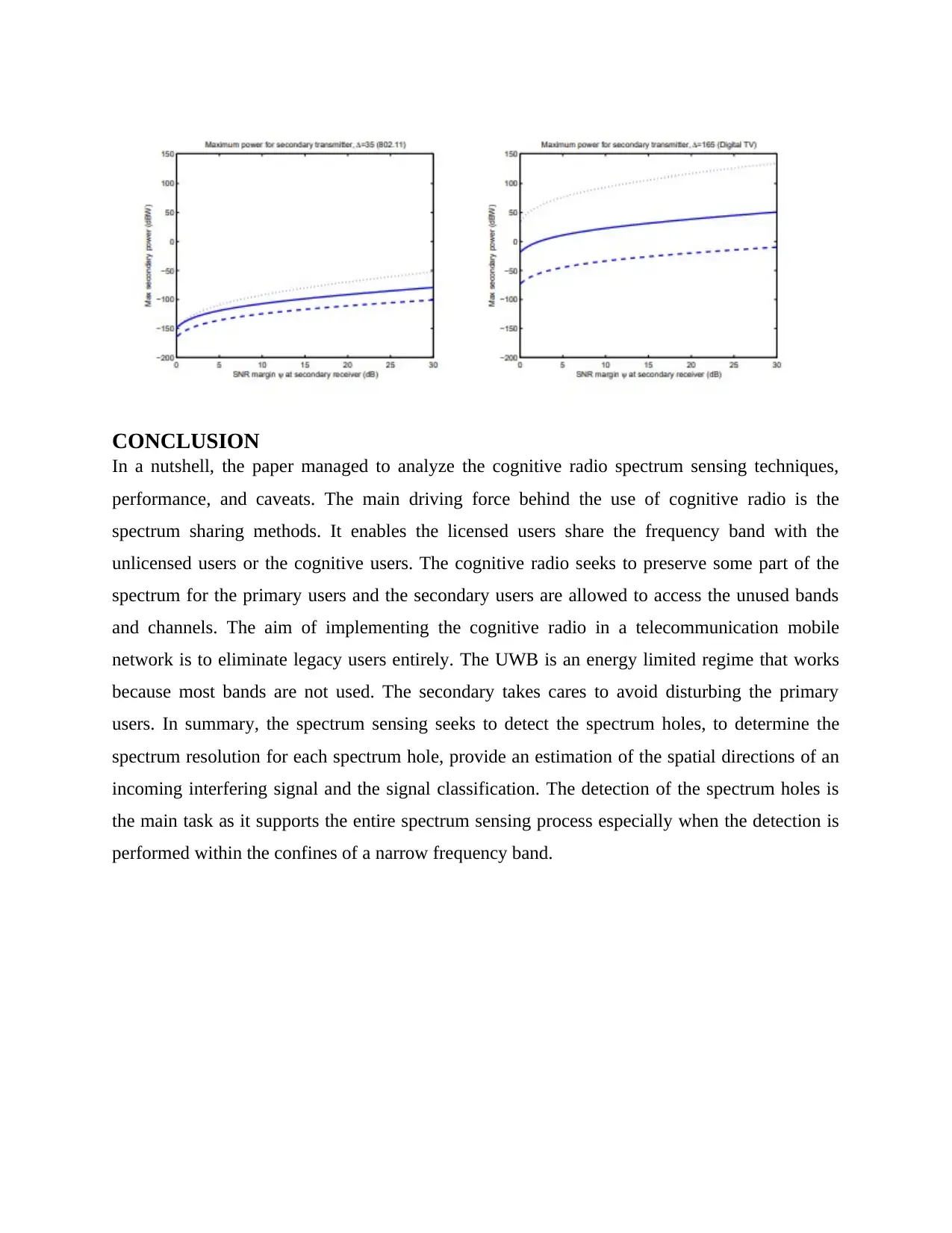
In a nutshell, the paper managed to analyze the cognitive radio spectrum sensing techniques,
performance, and caveats. The main driving force behind the use of cognitive radio is the
spectrum sharing methods. It enables the licensed users share the frequency band with the
unlicensed users or the cognitive users. The cognitive radio seeks to preserve some part of the
spectrum for the primary users and the secondary users are allowed to access the unused bands
and channels. The aim of implementing the cognitive radio in a telecommunication mobile
network is to eliminate legacy users entirely. The UWB is an energy limited regime that works
because most bands are not used. The secondary takes cares to avoid disturbing the primary
users. In summary, the spectrum sensing seeks to detect the spectrum holes, to determine the
spectrum resolution for each spectrum hole, provide an estimation of the spatial directions of an
incoming interfering signal and the signal classification. The detection of the spectrum holes is
the main task as it supports the entire spectrum sensing process especially when the detection is
performed within the confines of a narrow frequency band.
⊘ This is a preview!⊘
Do you want full access?
Subscribe today to unlock all pages.

Trusted by 1+ million students worldwide
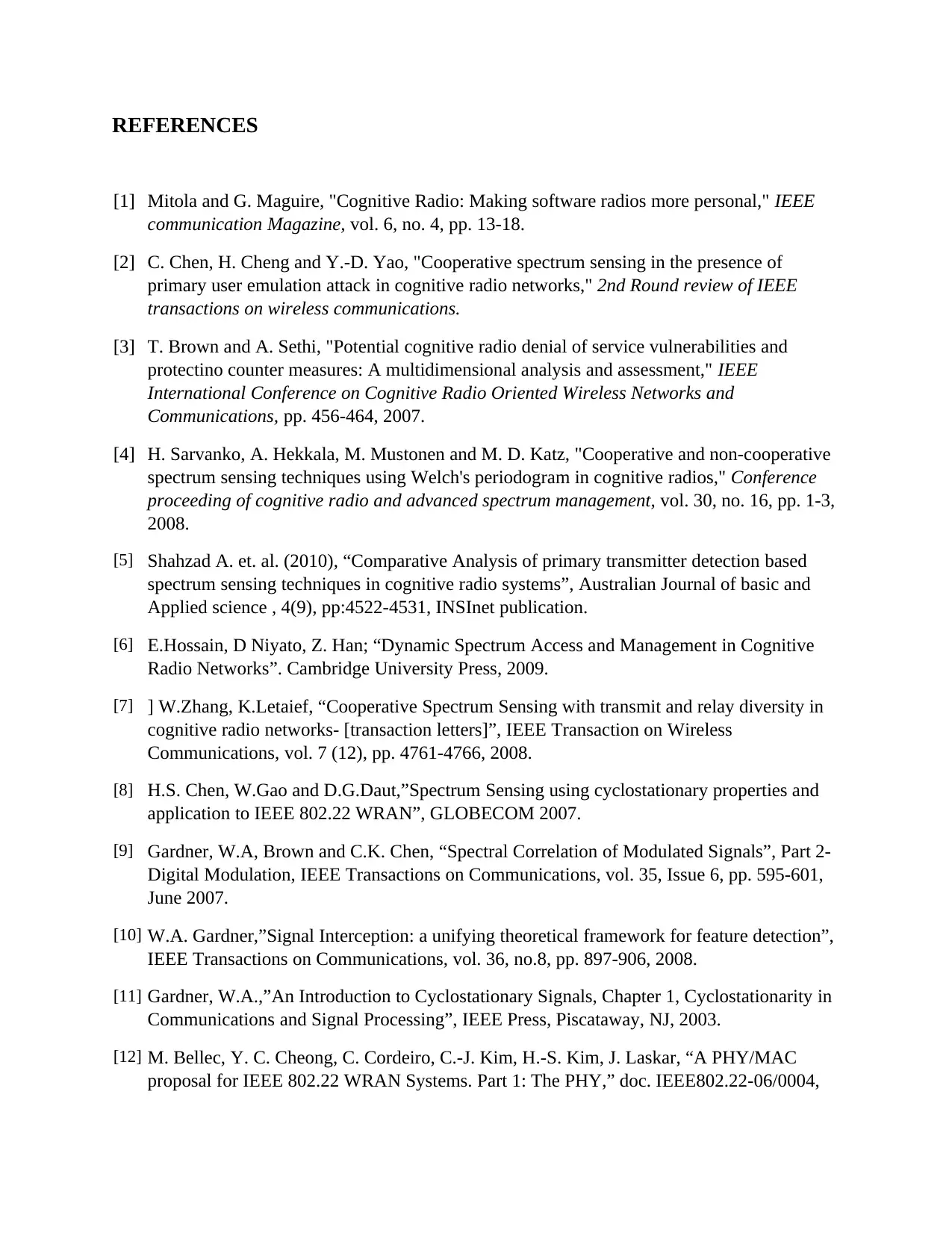
[1] Mitola and G. Maguire, "Cognitive Radio: Making software radios more personal," IEEE
communication Magazine, vol. 6, no. 4, pp. 13-18.
[2] C. Chen, H. Cheng and Y.-D. Yao, "Cooperative spectrum sensing in the presence of
primary user emulation attack in cognitive radio networks," 2nd Round review of IEEE
transactions on wireless communications.
[3] T. Brown and A. Sethi, "Potential cognitive radio denial of service vulnerabilities and
protectino counter measures: A multidimensional analysis and assessment," IEEE
International Conference on Cognitive Radio Oriented Wireless Networks and
Communications, pp. 456-464, 2007.
[4] H. Sarvanko, A. Hekkala, M. Mustonen and M. D. Katz, "Cooperative and non-cooperative
spectrum sensing techniques using Welch's periodogram in cognitive radios," Conference
proceeding of cognitive radio and advanced spectrum management, vol. 30, no. 16, pp. 1-3,
2008.
[5] Shahzad A. et. al. (2010), “Comparative Analysis of primary transmitter detection based
spectrum sensing techniques in cognitive radio systems”, Australian Journal of basic and
Applied science , 4(9), pp:4522-4531, INSInet publication.
[6] E.Hossain, D Niyato, Z. Han; “Dynamic Spectrum Access and Management in Cognitive
Radio Networks”. Cambridge University Press, 2009.
[7] ] W.Zhang, K.Letaief, “Cooperative Spectrum Sensing with transmit and relay diversity in
cognitive radio networks- [transaction letters]”, IEEE Transaction on Wireless
Communications, vol. 7 (12), pp. 4761-4766, 2008.
[8] H.S. Chen, W.Gao and D.G.Daut,”Spectrum Sensing using cyclostationary properties and
application to IEEE 802.22 WRAN”, GLOBECOM 2007.
[9] Gardner, W.A, Brown and C.K. Chen, “Spectral Correlation of Modulated Signals”, Part 2-
Digital Modulation, IEEE Transactions on Communications, vol. 35, Issue 6, pp. 595-601,
June 2007.
[10] W.A. Gardner,”Signal Interception: a unifying theoretical framework for feature detection”,
IEEE Transactions on Communications, vol. 36, no.8, pp. 897-906, 2008.
[11] Gardner, W.A.,”An Introduction to Cyclostationary Signals, Chapter 1, Cyclostationarity in
Communications and Signal Processing”, IEEE Press, Piscataway, NJ, 2003.
[12] M. Bellec, Y. C. Cheong, C. Cordeiro, C.-J. Kim, H.-S. Kim, J. Laskar, “A PHY/MAC
proposal for IEEE 802.22 WRAN Systems. Part 1: The PHY,” doc. IEEE802.22-06/0004,
Paraphrase This Document

[13] W. A. Gardner and C. M. Spooner, “Signal interception: Performance advantages of cyclic-
feature detectors,” IEEE Trans. Commun., vol. 40, pp. 149-159, Aug. 1992.
[14] K. Kim, I. A. Akbar, K. K. Bae, J.-S. Um, C. M. Spooner, and J. H. Reed, “Cyclostationary
approaches to signal detection and classification in cognitive radio,” submitted for
presentation at IEEE DySpan 2007.
[15] A. Batra, W. Krenik, and C. Panasik, “Cognitive radios for unlicensed WANs,” presented at
the BWRC Cognitive Radio Workshop, 2004.
[16] W. Krenik and A. Batra, “Cognitive radio techniques for wide area networks,” in Proc.
Conf. Design Automation, Anaheim, CA, 2005, pp.409-412.
[17] Bin Le, Building a Cognitive Radio: From architecture definition to prototype
implementation, 2007, Doctor of Philosophy Dissertation, Virginia Polytechnic Institute and
State University.
[18] S. Haykin, “Cognitive Radio: Brain empowered wireless communications”, IEEE Journal
on Selected Areas in Communications, vol. 23, no.2, pp. 201-220, Feb. 2005.
[19] D. Cabric, S.M.Mishra and R.W. Brodersen.”Implementation issues in spectrum sensing for
cognitive radios”, in proceedings of the Thirty-Eighth Asilomar Conference on Signals,
vol.1, Nov 2004, pp. 772-776.
[20] Z.-B. Tang, K. R. Pattipati, and D. L. Kleinman, “An algorithm for determining the decision
threshold in a distributed detection problem,” IEEE Trans. Syst. Sci. Cybern., vol. 21, pp.
231-237, Jan./Feb. 2001.
APPENDIX
Probability density function of random variable X

{ 1
25 x− 1
5
−1
25 x+ 3
5
0
,
5≤ x ≤ 10 ,
10≤ x ≤ 15 ,
elsewhere }a. 7 marks
Find P ( 9 ≤ x ≤11 )
Use the symmetry of the probability density function to simplify the calculation.
¿∫
9
11
fx ( X ) =∫
9
10
0.04 x−0.2−∫
10
11
0.04 x +0.6
¿∫
9
11
fx ( X ) =¿
%% Digital Transmission - N bit packets
... Student Details
... Week 4-5 Practical 4-5
%% QUESTION I
for x = 1:10
disp(x)
end
clc;
clear all;
close all;
% Method-1:
format long
N=[8 16];
n=100;
PBL=10^-6;
PBH=0.5;
log_PBL=log(PBL);
log_PBH=log(PBH);
dx=(log_PBH-log_PBL)/(n-1);
log_PB=(log_PBL:dx:log_PBH);
PB=exp(log_PB);
for iN= 1: length(N)
for iPB=1:n
P=0;
for i=1:2^N(iN)-1
z=integer2binary(i,N(iN));
S=sum(z);
P=P+(PB(iPB)^S)*(1-PB(iPB))^(N(iN)-S);
end
P_packet(iN,iPB)=P;
end
end
figure(1)
loglog(PB,P_packet(1,:),'b',PB,P_packet(2,:),'r')
% Method-2:
N=[8 16 32 64];
for iN=1:length(N)
⊘ This is a preview!⊘
Do you want full access?
Subscribe today to unlock all pages.

Trusted by 1+ million students worldwide
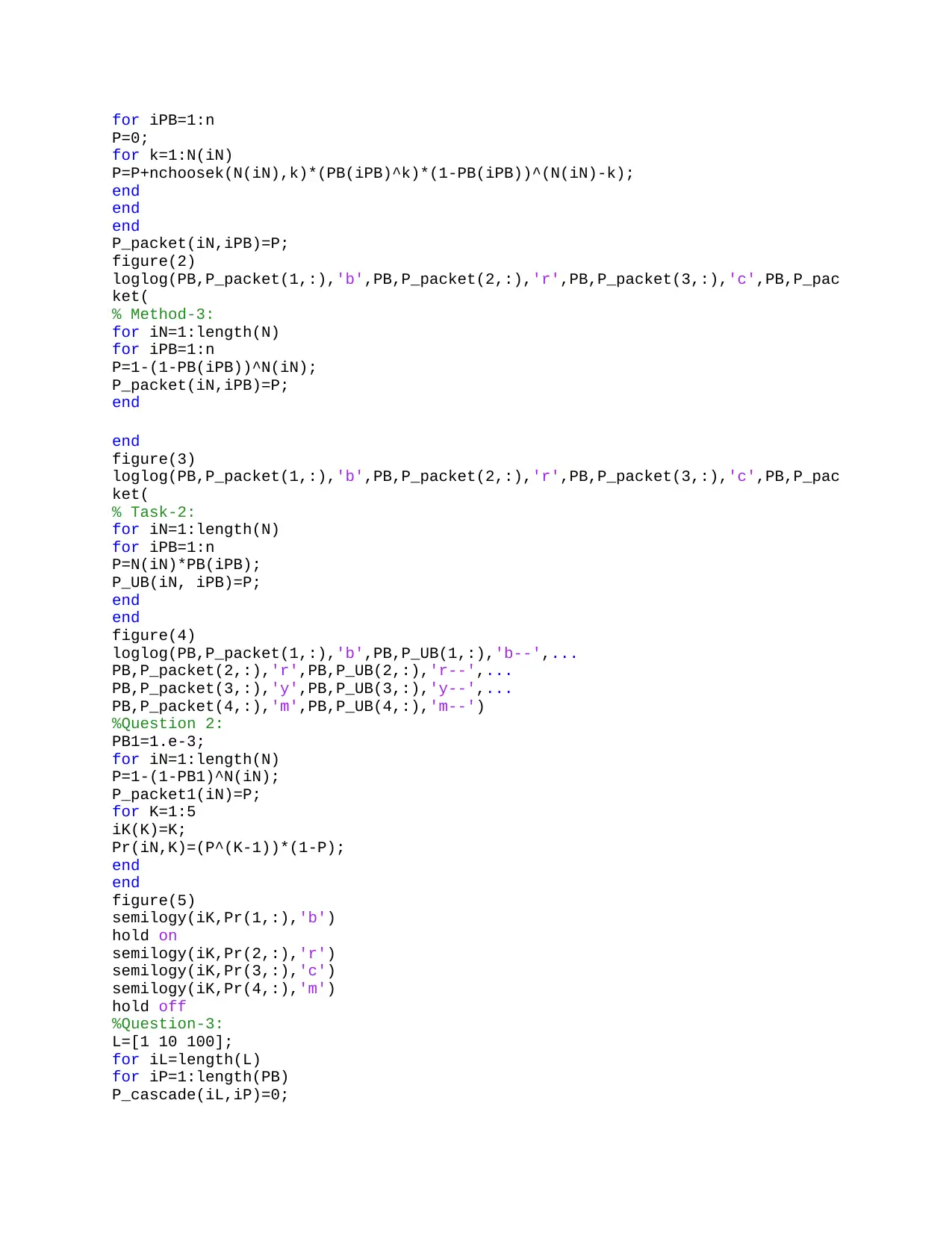
P=0;
for k=1:N(iN)
P=P+nchoosek(N(iN),k)*(PB(iPB)^k)*(1-PB(iPB))^(N(iN)-k);
end
end
end
P_packet(iN,iPB)=P;
figure(2)
loglog(PB,P_packet(1,:),'b',PB,P_packet(2,:),'r',PB,P_packet(3,:),'c',PB,P_pac
ket(
% Method-3:
for iN=1:length(N)
for iPB=1:n
P=1-(1-PB(iPB))^N(iN);
P_packet(iN,iPB)=P;
end
end
figure(3)
loglog(PB,P_packet(1,:),'b',PB,P_packet(2,:),'r',PB,P_packet(3,:),'c',PB,P_pac
ket(
% Task-2:
for iN=1:length(N)
for iPB=1:n
P=N(iN)*PB(iPB);
P_UB(iN, iPB)=P;
end
end
figure(4)
loglog(PB,P_packet(1,:),'b',PB,P_UB(1,:),'b--',...
PB,P_packet(2,:),'r',PB,P_UB(2,:),'r--',...
PB,P_packet(3,:),'y',PB,P_UB(3,:),'y--',...
PB,P_packet(4,:),'m',PB,P_UB(4,:),'m--')
%Question 2:
PB1=1.e-3;
for iN=1:length(N)
P=1-(1-PB1)^N(iN);
P_packet1(iN)=P;
for K=1:5
iK(K)=K;
Pr(iN,K)=(P^(K-1))*(1-P);
end
end
figure(5)
semilogy(iK,Pr(1,:),'b')
hold on
semilogy(iK,Pr(2,:),'r')
semilogy(iK,Pr(3,:),'c')
semilogy(iK,Pr(4,:),'m')
hold off
%Question-3:
L=[1 10 100];
for iL=length(L)
for iP=1:length(PB)
P_cascade(iL,iP)=0;
Paraphrase This Document

P_cascade(iL,iP)=P_cascade(iL,iP)+nchoosek(L(iL),k)*...
(PB(iP)^k)*(1-PB(iP))^(L(iL)-k);
end
end
end
figure(6)
loglog(PB,P_cascade(1,:),'b',PB,P_cascade(2,:),'r',PB,P_cascade(3,:),'c')
10-6 10-5 10-4 10-3 10-2 10-1 100
10-6
10-5
10-4
10-3
10-2
10-1
100
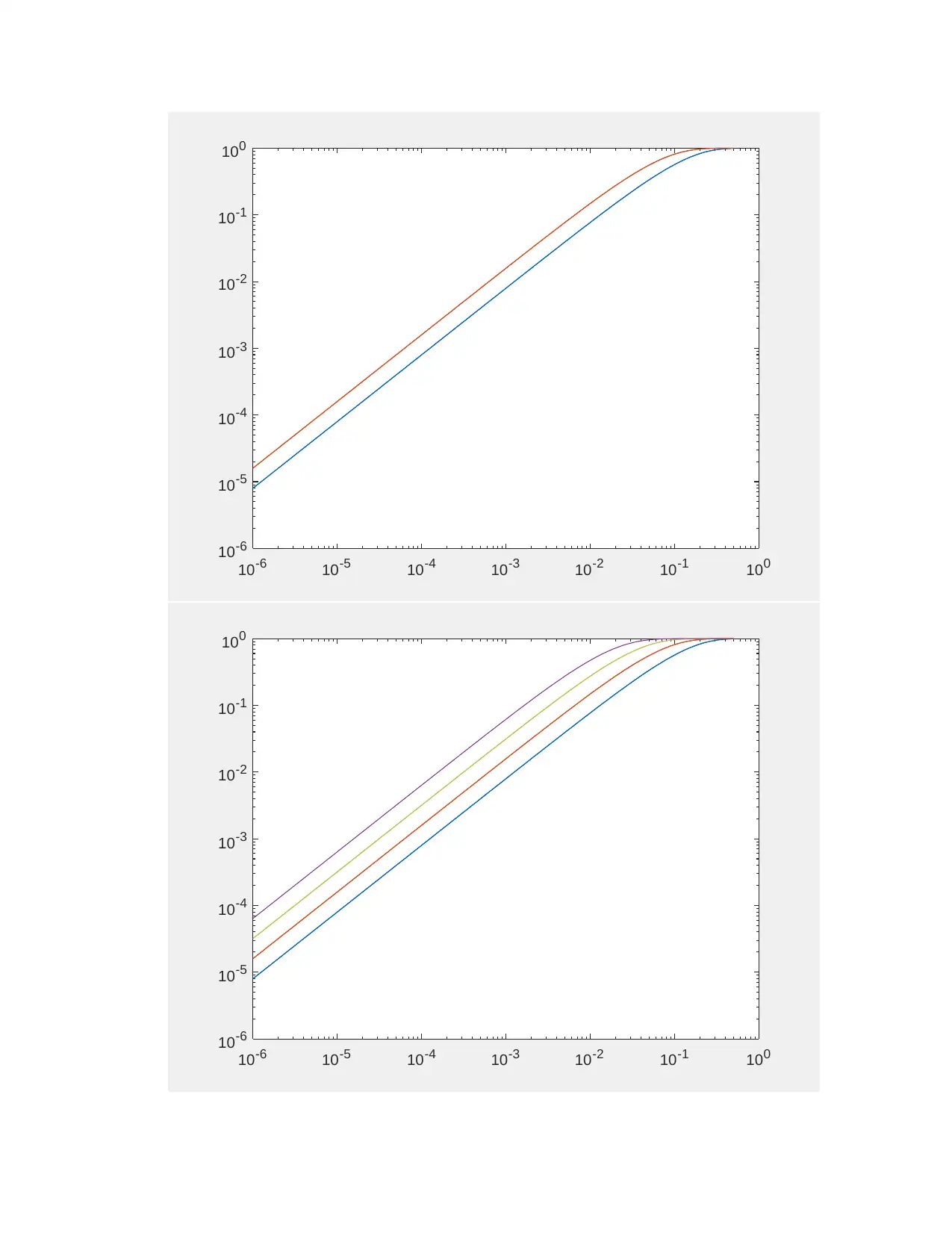
10-6
10-5
10-4
10-3
10-2
10-1
100
10-6 10-5 10-4 10-3 10-2 10-1 100
10-6
10-5
10-4
10-3
10-2
10-1
100
⊘ This is a preview!⊘
Do you want full access?
Subscribe today to unlock all pages.

Trusted by 1+ million students worldwide

10-6
10-4
10-2
100
102
1 1.5 2 2.5 3 3.5 4 4.5 5
10-10
10-8
10-6
10-4
10-2
100
Paraphrase This Document
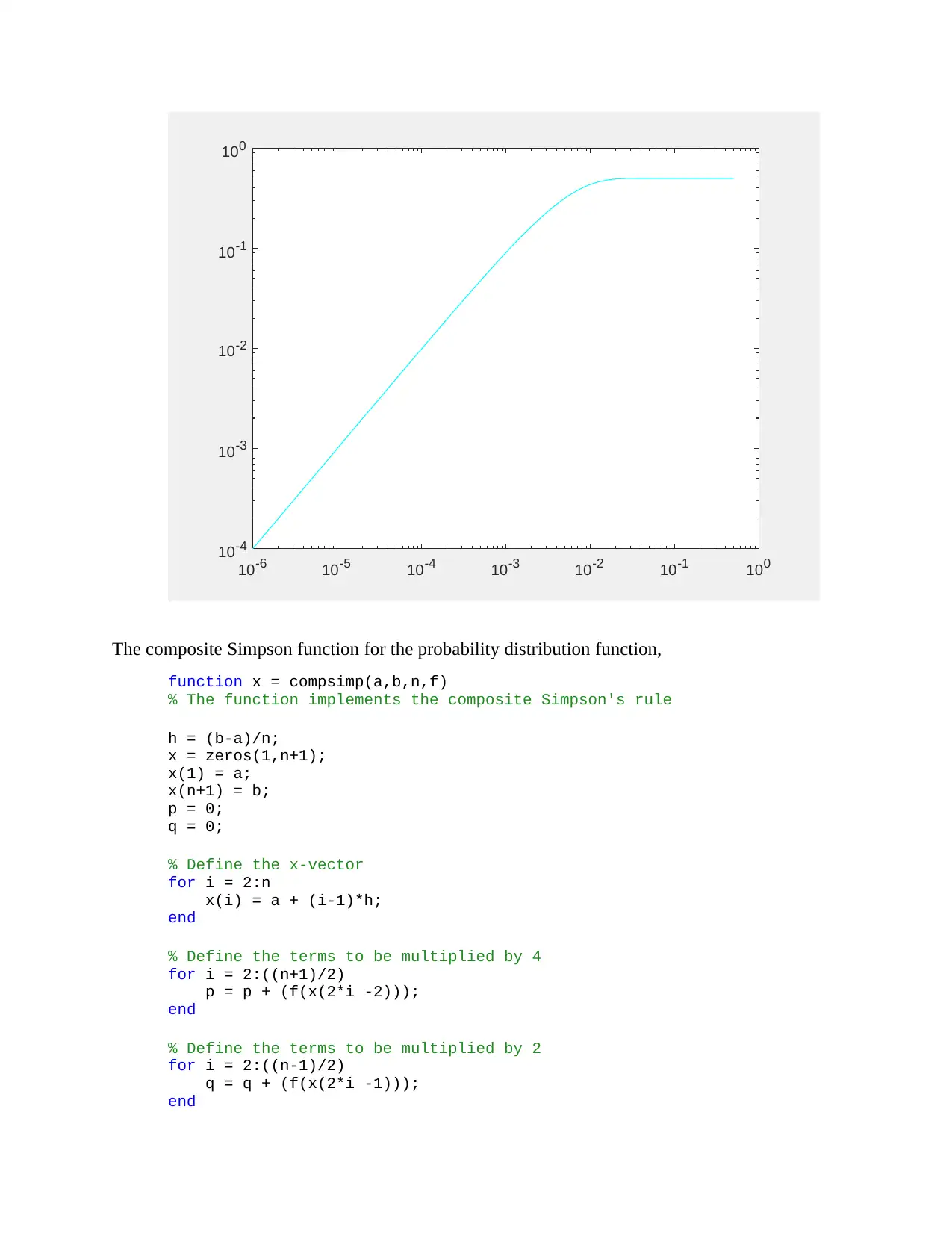
10-4
10-3
10-2
10-1
100
The composite Simpson function for the probability distribution function,
function x = compsimp(a,b,n,f)
% The function implements the composite Simpson's rule
h = (b-a)/n;
x = zeros(1,n+1);
x(1) = a;
x(n+1) = b;
p = 0;
q = 0;
% Define the x-vector
for i = 2:n
x(i) = a + (i-1)*h;
end
% Define the terms to be multiplied by 4
for i = 2:((n+1)/2)
p = p + (f(x(2*i -2)));
end
% Define the terms to be multiplied by 2
for i = 2:((n-1)/2)
q = q + (f(x(2*i -1)));
end

x = (h/3)*(f(a) + 2*q + 4*p + f(b));
disp (x)
Receiver Operating Characteristics Graphs
When the simulation is reduced to 100 instead of 1000 the simulation run time is equally
reduced. The difference between the 100 simulations and the 1000 simulations populated earlier
is the smoothness of the ROC curves. The more the simulations carried out, the more the
precision of the signal is achieved.
Spectrum Sensing Energy Detection Simulation
Es/No=[ 3.000000 dB 6.000000 dB 10.000000 dB ]
Es/No= 3.000000 dB, Threshold= 0.000000, Pr_detect= 1.00000000e+00
Pr_fa= 1.00000000e+00
Es/No= 3.000000 dB, Threshold= 0.500000, Pr_detect= 1.00000000e+00
Pr_fa= 1.00000000e+00
Es/No= 3.000000 dB, Threshold= 1.000000, Pr_detect= 1.00000000e+00
Pr_fa= 1.00000000e+00
Es/No= 3.000000 dB, Threshold= 1.500000, Pr_detect= 1.00000000e+00
Pr_fa= 9.99999900e-01
Es/No= 3.000000 dB, Threshold= 2.000000, Pr_detect= 9.99998500e-01
Pr_fa= 9.99994300e-01
⊘ This is a preview!⊘
Do you want full access?
Subscribe today to unlock all pages.

Trusted by 1+ million students worldwide
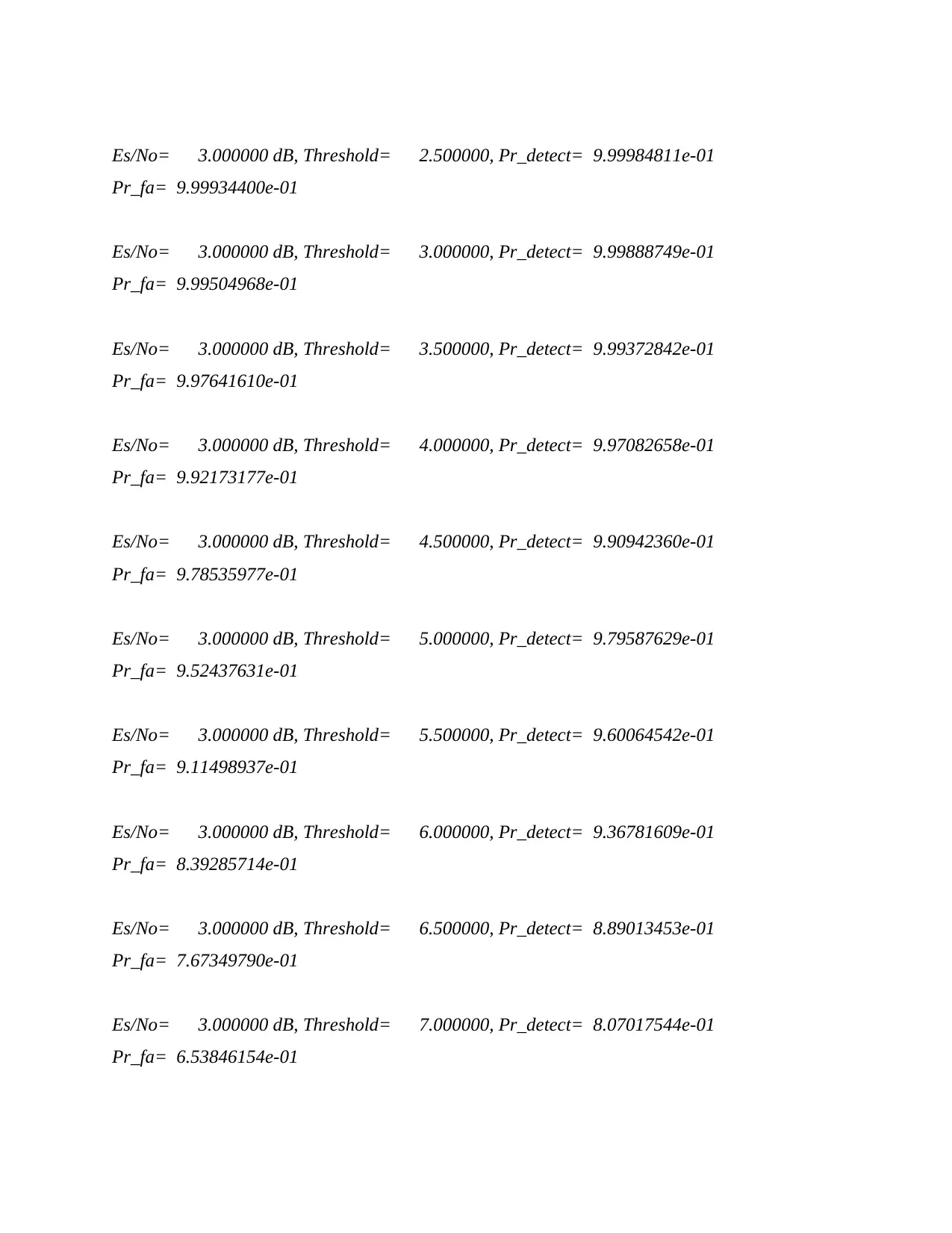
Pr_fa= 9.99934400e-01
Es/No= 3.000000 dB, Threshold= 3.000000, Pr_detect= 9.99888749e-01
Pr_fa= 9.99504968e-01
Es/No= 3.000000 dB, Threshold= 3.500000, Pr_detect= 9.99372842e-01
Pr_fa= 9.97641610e-01
Es/No= 3.000000 dB, Threshold= 4.000000, Pr_detect= 9.97082658e-01
Pr_fa= 9.92173177e-01
Es/No= 3.000000 dB, Threshold= 4.500000, Pr_detect= 9.90942360e-01
Pr_fa= 9.78535977e-01
Es/No= 3.000000 dB, Threshold= 5.000000, Pr_detect= 9.79587629e-01
Pr_fa= 9.52437631e-01
Es/No= 3.000000 dB, Threshold= 5.500000, Pr_detect= 9.60064542e-01
Pr_fa= 9.11498937e-01
Es/No= 3.000000 dB, Threshold= 6.000000, Pr_detect= 9.36781609e-01
Pr_fa= 8.39285714e-01
Es/No= 3.000000 dB, Threshold= 6.500000, Pr_detect= 8.89013453e-01
Pr_fa= 7.67349790e-01
Es/No= 3.000000 dB, Threshold= 7.000000, Pr_detect= 8.07017544e-01
Pr_fa= 6.53846154e-01
Paraphrase This Document
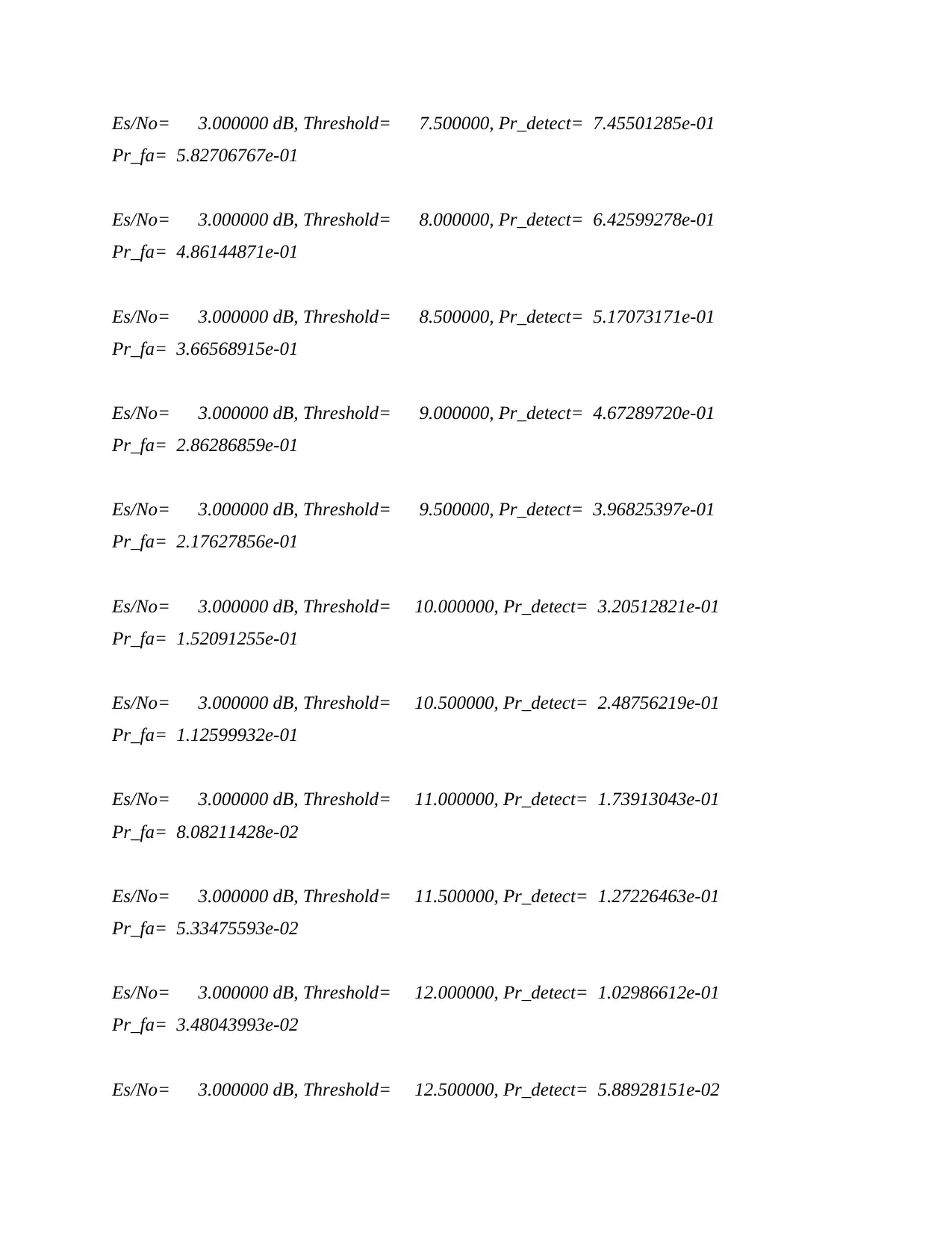
Pr_fa= 5.82706767e-01
Es/No= 3.000000 dB, Threshold= 8.000000, Pr_detect= 6.42599278e-01
Pr_fa= 4.86144871e-01
Es/No= 3.000000 dB, Threshold= 8.500000, Pr_detect= 5.17073171e-01
Pr_fa= 3.66568915e-01
Es/No= 3.000000 dB, Threshold= 9.000000, Pr_detect= 4.67289720e-01
Pr_fa= 2.86286859e-01
Es/No= 3.000000 dB, Threshold= 9.500000, Pr_detect= 3.96825397e-01
Pr_fa= 2.17627856e-01
Es/No= 3.000000 dB, Threshold= 10.000000, Pr_detect= 3.20512821e-01
Pr_fa= 1.52091255e-01
Es/No= 3.000000 dB, Threshold= 10.500000, Pr_detect= 2.48756219e-01
Pr_fa= 1.12599932e-01
Es/No= 3.000000 dB, Threshold= 11.000000, Pr_detect= 1.73913043e-01
Pr_fa= 8.08211428e-02
Es/No= 3.000000 dB, Threshold= 11.500000, Pr_detect= 1.27226463e-01
Pr_fa= 5.33475593e-02
Es/No= 3.000000 dB, Threshold= 12.000000, Pr_detect= 1.02986612e-01
Pr_fa= 3.48043993e-02
Es/No= 3.000000 dB, Threshold= 12.500000, Pr_detect= 5.88928151e-02
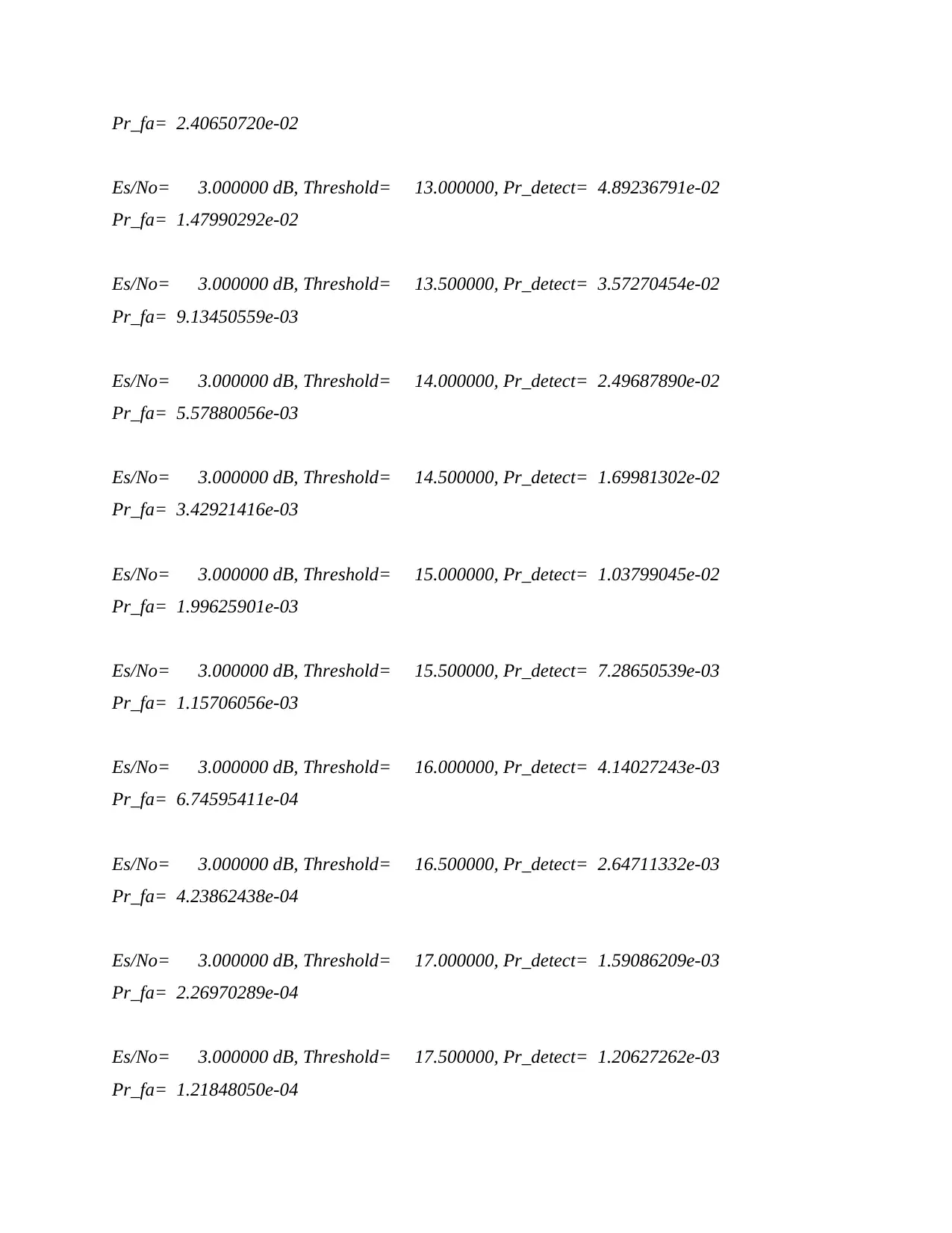
Es/No= 3.000000 dB, Threshold= 13.000000, Pr_detect= 4.89236791e-02
Pr_fa= 1.47990292e-02
Es/No= 3.000000 dB, Threshold= 13.500000, Pr_detect= 3.57270454e-02
Pr_fa= 9.13450559e-03
Es/No= 3.000000 dB, Threshold= 14.000000, Pr_detect= 2.49687890e-02
Pr_fa= 5.57880056e-03
Es/No= 3.000000 dB, Threshold= 14.500000, Pr_detect= 1.69981302e-02
Pr_fa= 3.42921416e-03
Es/No= 3.000000 dB, Threshold= 15.000000, Pr_detect= 1.03799045e-02
Pr_fa= 1.99625901e-03
Es/No= 3.000000 dB, Threshold= 15.500000, Pr_detect= 7.28650539e-03
Pr_fa= 1.15706056e-03
Es/No= 3.000000 dB, Threshold= 16.000000, Pr_detect= 4.14027243e-03
Pr_fa= 6.74595411e-04
Es/No= 3.000000 dB, Threshold= 16.500000, Pr_detect= 2.64711332e-03
Pr_fa= 4.23862438e-04
Es/No= 3.000000 dB, Threshold= 17.000000, Pr_detect= 1.59086209e-03
Pr_fa= 2.26970289e-04
Es/No= 3.000000 dB, Threshold= 17.500000, Pr_detect= 1.20627262e-03
Pr_fa= 1.21848050e-04
⊘ This is a preview!⊘
Do you want full access?
Subscribe today to unlock all pages.

Trusted by 1+ million students worldwide

Pr_fa= 6.53000000e-05
Es/No= 3.000000 dB, Threshold= 18.500000, Pr_detect= 3.87295169e-04
Pr_fa= 3.49000000e-05
Es/No= 3.000000 dB, Threshold= 19.000000, Pr_detect= 2.24331939e-04
Pr_fa= 2.20000000e-05
Es/No= 3.000000 dB, Threshold= 19.500000, Pr_detect= 1.19329179e-04
Pr_fa= 1.03000000e-05
Es/No= 3.000000 dB, Threshold= 20.000000, Pr_detect= 8.75596172e-05
Pr_fa= 5.00000000e-06
Es/No= 3.000000 dB, Threshold= 20.500000, Pr_detect= 5.17920301e-05
Pr_fa= 2.10000000e-06
Es/No= 3.000000 dB, Threshold= 21.000000, Pr_detect= 3.01268067e-05
Pr_fa= 2.20000000e-06
Es/No= 3.000000 dB, Threshold= 21.500000, Pr_detect= 1.35123011e-05
Pr_fa= 1.00000000e-06
Es/No= 3.000000 dB, Threshold= 22.000000, Pr_detect= 8.50000000e-06
Pr_fa= 5.00000000e-07
Es/No= 3.000000 dB, Threshold= 22.500000, Pr_detect= 4.80000000e-06
Pr_fa= 3.00000000e-07
Paraphrase This Document
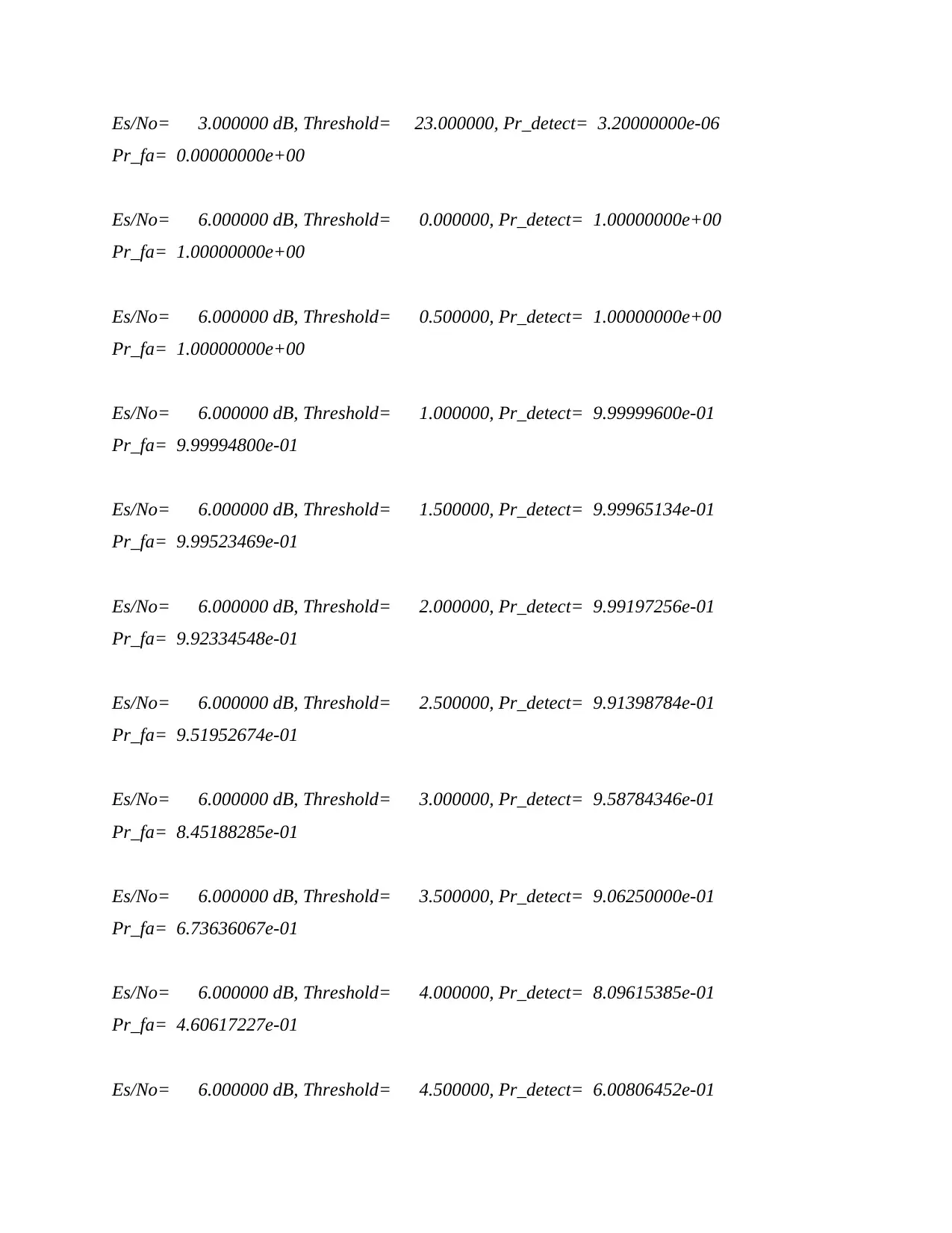
Pr_fa= 0.00000000e+00
Es/No= 6.000000 dB, Threshold= 0.000000, Pr_detect= 1.00000000e+00
Pr_fa= 1.00000000e+00
Es/No= 6.000000 dB, Threshold= 0.500000, Pr_detect= 1.00000000e+00
Pr_fa= 1.00000000e+00
Es/No= 6.000000 dB, Threshold= 1.000000, Pr_detect= 9.99999600e-01
Pr_fa= 9.99994800e-01
Es/No= 6.000000 dB, Threshold= 1.500000, Pr_detect= 9.99965134e-01
Pr_fa= 9.99523469e-01
Es/No= 6.000000 dB, Threshold= 2.000000, Pr_detect= 9.99197256e-01
Pr_fa= 9.92334548e-01
Es/No= 6.000000 dB, Threshold= 2.500000, Pr_detect= 9.91398784e-01
Pr_fa= 9.51952674e-01
Es/No= 6.000000 dB, Threshold= 3.000000, Pr_detect= 9.58784346e-01
Pr_fa= 8.45188285e-01
Es/No= 6.000000 dB, Threshold= 3.500000, Pr_detect= 9.06250000e-01
Pr_fa= 6.73636067e-01
Es/No= 6.000000 dB, Threshold= 4.000000, Pr_detect= 8.09615385e-01
Pr_fa= 4.60617227e-01
Es/No= 6.000000 dB, Threshold= 4.500000, Pr_detect= 6.00806452e-01
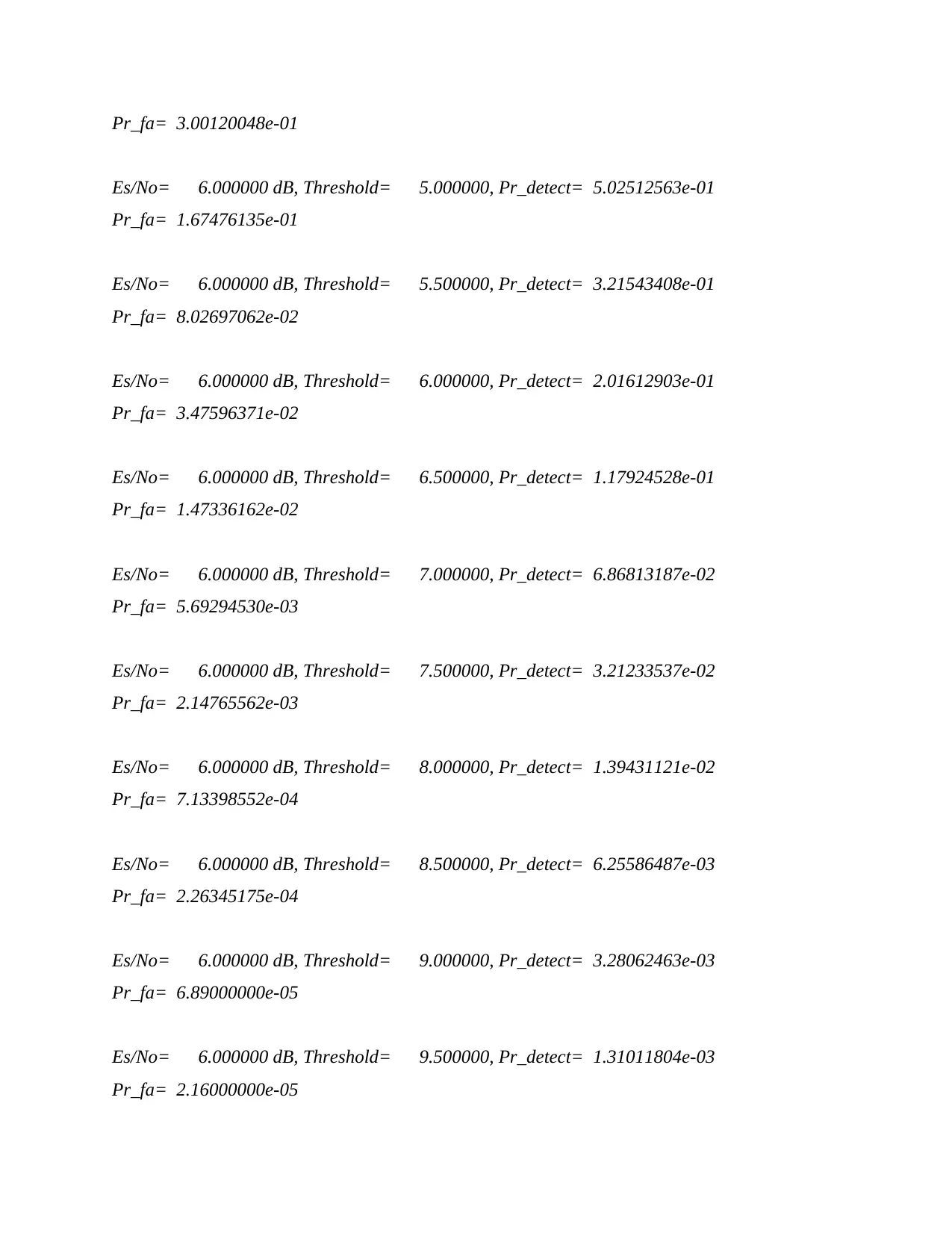
Es/No= 6.000000 dB, Threshold= 5.000000, Pr_detect= 5.02512563e-01
Pr_fa= 1.67476135e-01
Es/No= 6.000000 dB, Threshold= 5.500000, Pr_detect= 3.21543408e-01
Pr_fa= 8.02697062e-02
Es/No= 6.000000 dB, Threshold= 6.000000, Pr_detect= 2.01612903e-01
Pr_fa= 3.47596371e-02
Es/No= 6.000000 dB, Threshold= 6.500000, Pr_detect= 1.17924528e-01
Pr_fa= 1.47336162e-02
Es/No= 6.000000 dB, Threshold= 7.000000, Pr_detect= 6.86813187e-02
Pr_fa= 5.69294530e-03
Es/No= 6.000000 dB, Threshold= 7.500000, Pr_detect= 3.21233537e-02
Pr_fa= 2.14765562e-03
Es/No= 6.000000 dB, Threshold= 8.000000, Pr_detect= 1.39431121e-02
Pr_fa= 7.13398552e-04
Es/No= 6.000000 dB, Threshold= 8.500000, Pr_detect= 6.25586487e-03
Pr_fa= 2.26345175e-04
Es/No= 6.000000 dB, Threshold= 9.000000, Pr_detect= 3.28062463e-03
Pr_fa= 6.89000000e-05
Es/No= 6.000000 dB, Threshold= 9.500000, Pr_detect= 1.31011804e-03
Pr_fa= 2.16000000e-05
⊘ This is a preview!⊘
Do you want full access?
Subscribe today to unlock all pages.

Trusted by 1+ million students worldwide
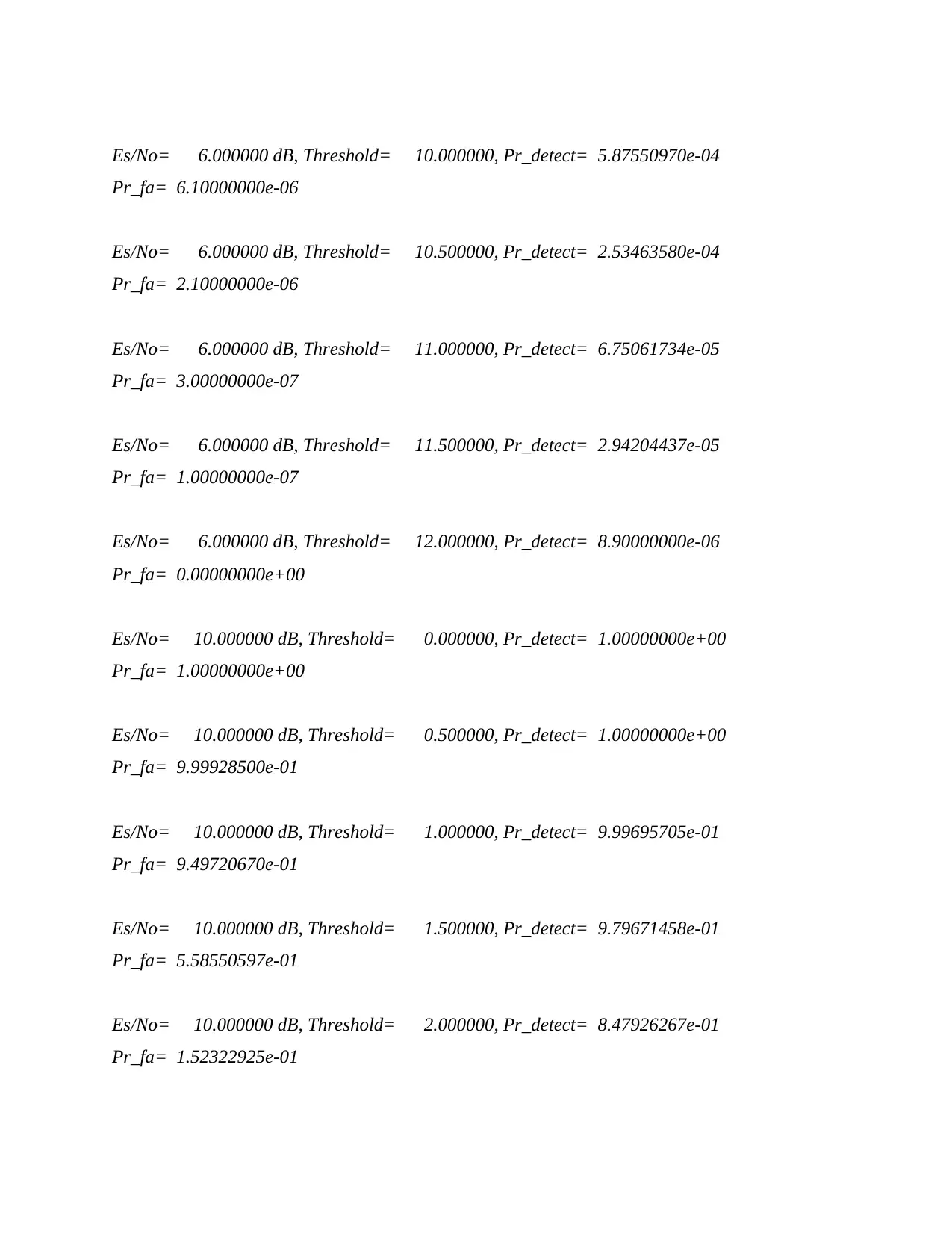
Pr_fa= 6.10000000e-06
Es/No= 6.000000 dB, Threshold= 10.500000, Pr_detect= 2.53463580e-04
Pr_fa= 2.10000000e-06
Es/No= 6.000000 dB, Threshold= 11.000000, Pr_detect= 6.75061734e-05
Pr_fa= 3.00000000e-07
Es/No= 6.000000 dB, Threshold= 11.500000, Pr_detect= 2.94204437e-05
Pr_fa= 1.00000000e-07
Es/No= 6.000000 dB, Threshold= 12.000000, Pr_detect= 8.90000000e-06
Pr_fa= 0.00000000e+00
Es/No= 10.000000 dB, Threshold= 0.000000, Pr_detect= 1.00000000e+00
Pr_fa= 1.00000000e+00
Es/No= 10.000000 dB, Threshold= 0.500000, Pr_detect= 1.00000000e+00
Pr_fa= 9.99928500e-01
Es/No= 10.000000 dB, Threshold= 1.000000, Pr_detect= 9.99695705e-01
Pr_fa= 9.49720670e-01
Es/No= 10.000000 dB, Threshold= 1.500000, Pr_detect= 9.79671458e-01
Pr_fa= 5.58550597e-01
Es/No= 10.000000 dB, Threshold= 2.000000, Pr_detect= 8.47926267e-01
Pr_fa= 1.52322925e-01
Paraphrase This Document
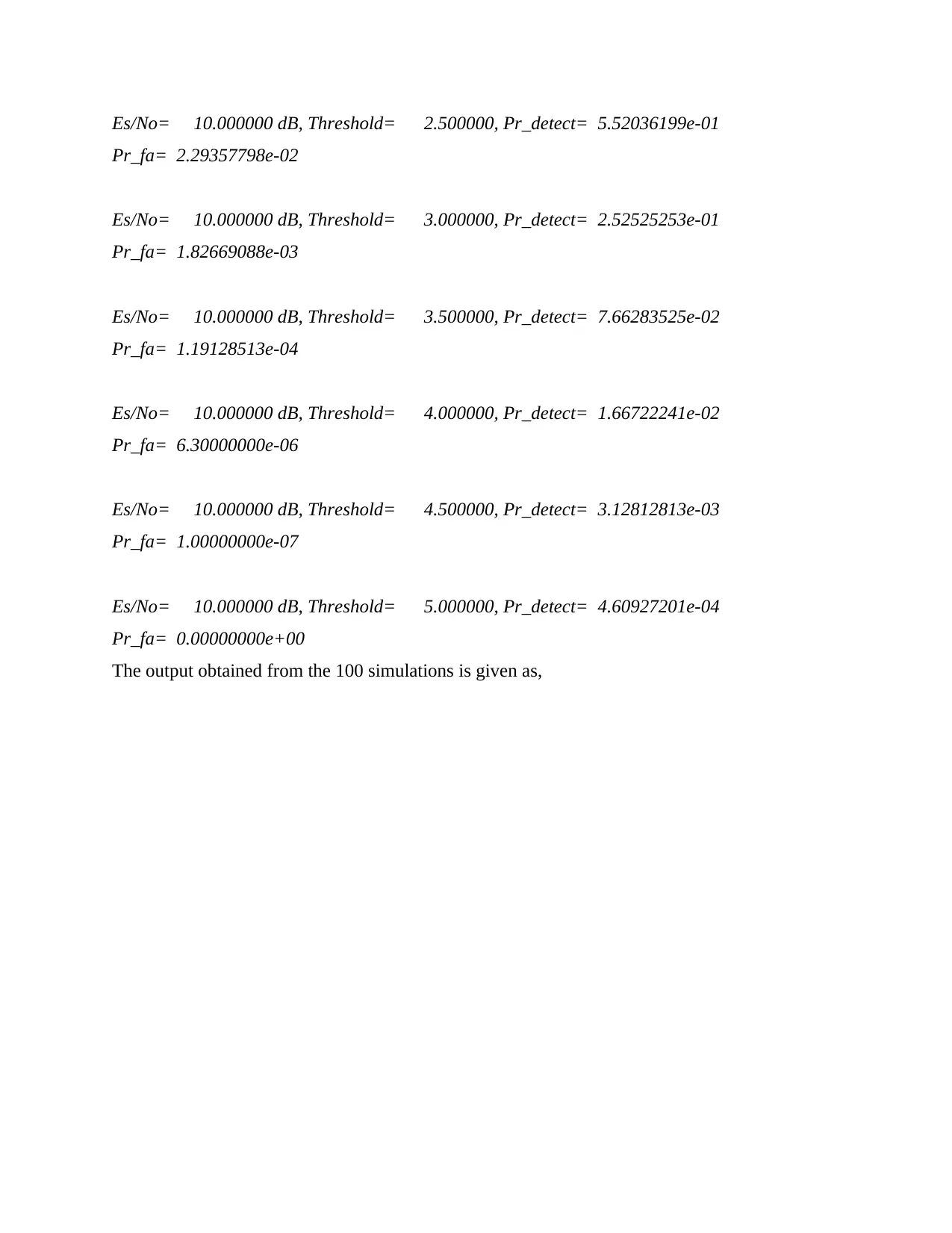
Pr_fa= 2.29357798e-02
Es/No= 10.000000 dB, Threshold= 3.000000, Pr_detect= 2.52525253e-01
Pr_fa= 1.82669088e-03
Es/No= 10.000000 dB, Threshold= 3.500000, Pr_detect= 7.66283525e-02
Pr_fa= 1.19128513e-04
Es/No= 10.000000 dB, Threshold= 4.000000, Pr_detect= 1.66722241e-02
Pr_fa= 6.30000000e-06
Es/No= 10.000000 dB, Threshold= 4.500000, Pr_detect= 3.12812813e-03
Pr_fa= 1.00000000e-07
Es/No= 10.000000 dB, Threshold= 5.000000, Pr_detect= 4.60927201e-04
Pr_fa= 0.00000000e+00
The output obtained from the 100 simulations is given as,
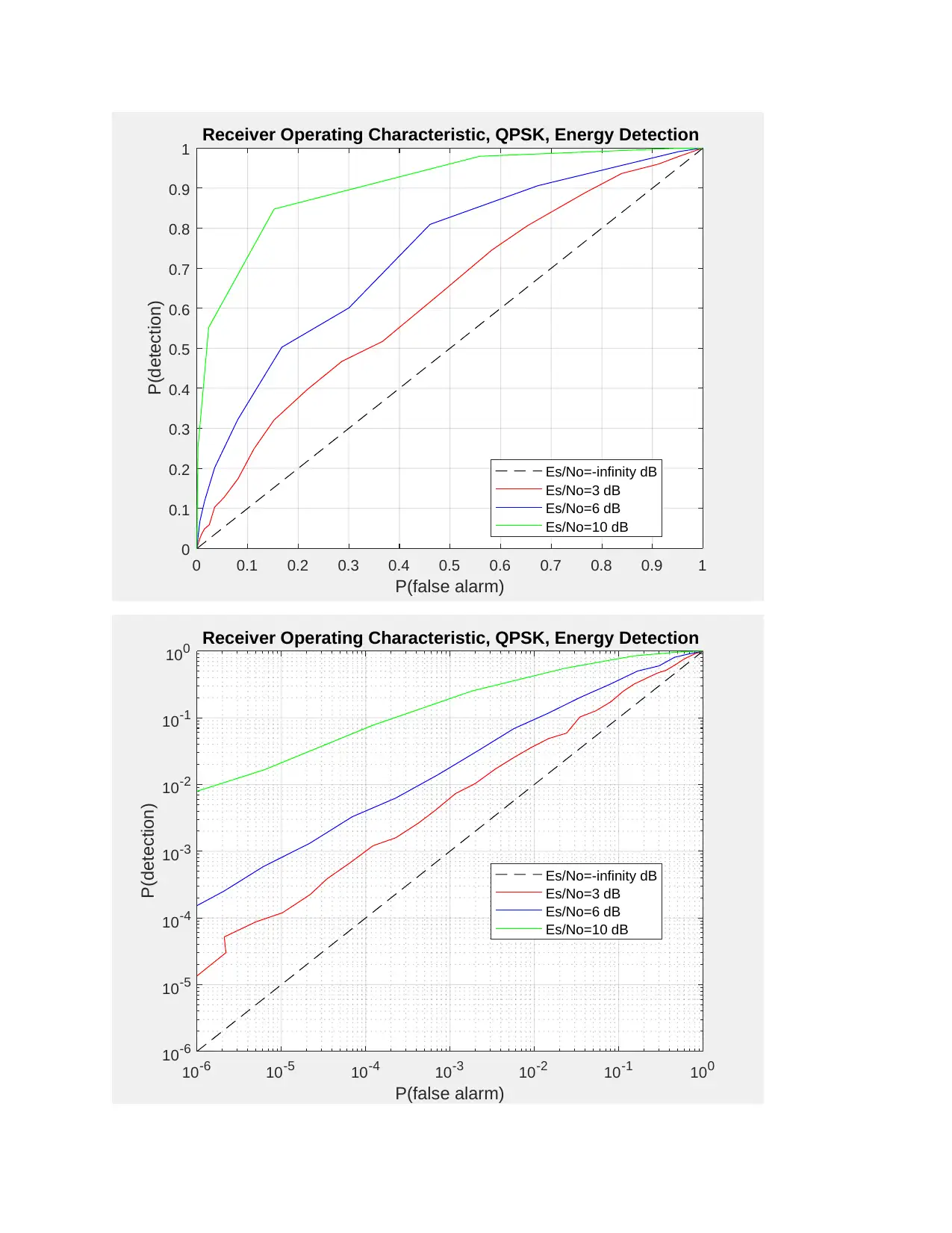
P(false alarm)
0
0.1
0.2
0.3
0.4
0.5
0.6
0.7
0.8
0.9
1
P(detection)
Receiver Operating Characteristic, QPSK, Energy Detection
Es/No=-infinity dB
Es/No=3 dB
Es/No=6 dB
Es/No=10 dB
10-6 10-5 10-4 10-3 10-2 10-1 100
P(false alarm)
10-6
10-5
10-4
10-3
10-2
10-1
100
P(detection)
Receiver Operating Characteristic, QPSK, Energy Detection
Es/No=-infinity dB
Es/No=3 dB
Es/No=6 dB
Es/No=10 dB
⊘ This is a preview!⊘
Do you want full access?
Subscribe today to unlock all pages.

Trusted by 1+ million students worldwide
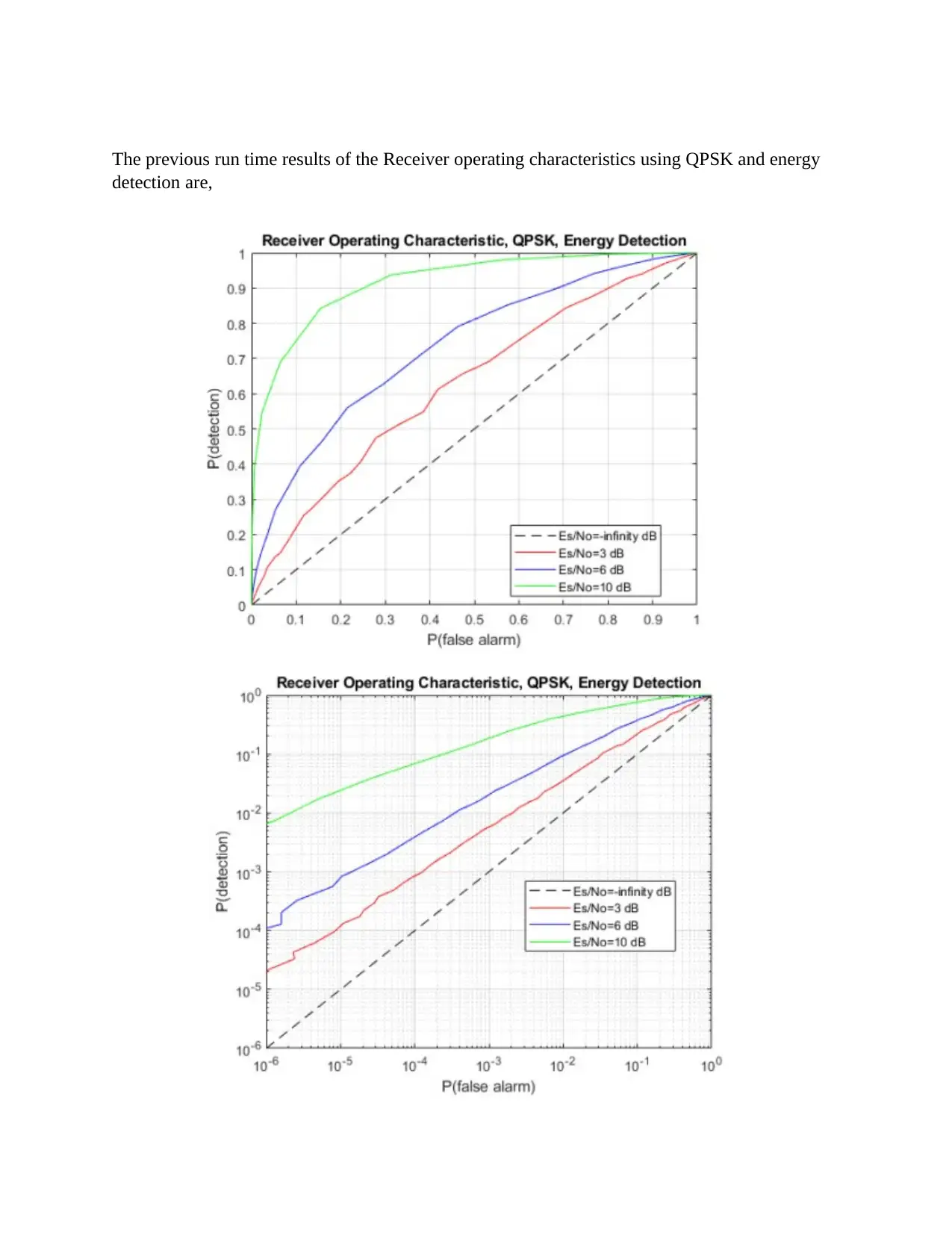
detection are,
Paraphrase This Document


⊘ This is a preview!⊘
Do you want full access?
Subscribe today to unlock all pages.

Trusted by 1+ million students worldwide
Related Documents
Your All-in-One AI-Powered Toolkit for Academic Success.
+13062052269
info@desklib.com
Available 24*7 on WhatsApp / Email
![[object Object]](/_next/static/media/star-bottom.7253800d.svg)
© 2024 | Zucol Services PVT LTD | All rights reserved.



